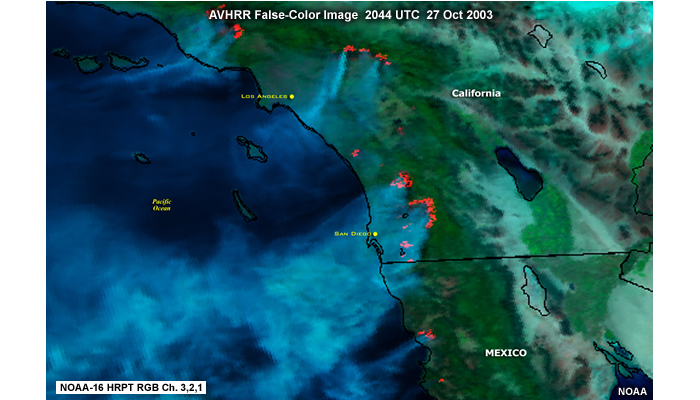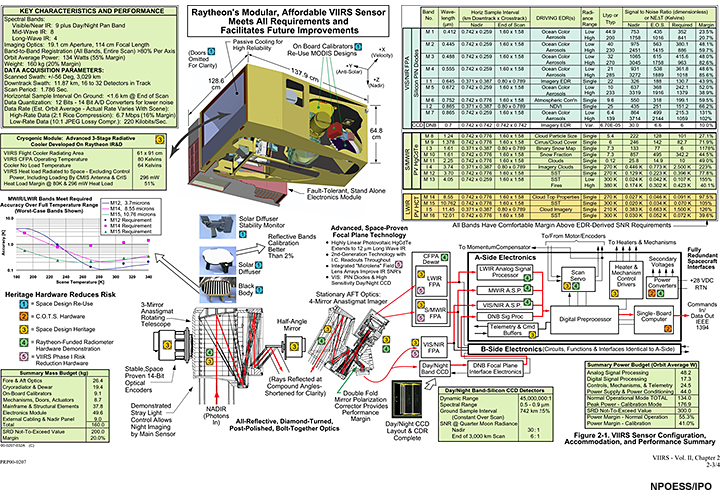Introduction
Introduction » Overview
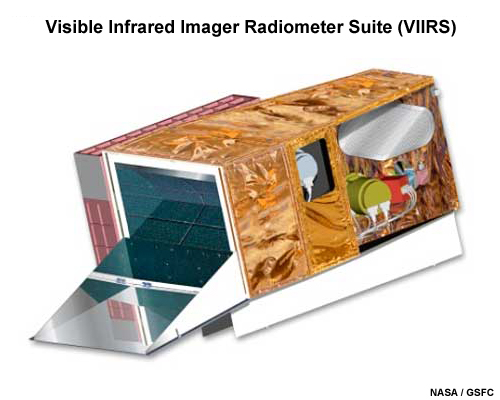
This module introduces the next-generation imagery that is being produced from the Visible/Infrared Imager/Radiometer Suite (or VIIRS) starting with the recently launched Suomi NPP polar-orbiting satellite and continuing on board future U.S. JPSS (Joint Polar Satellite System) weather satellites.
The VIIRS imager has many advanced features that improve both spectral and spatial resolution. Together with modernized data communication and processing systems, VIIRS will provide consistent, high quality, and high resolution data to users. The module covers the enhanced capabilities of VIIRS by examining the systems that contributed to its development. Special attention is paid to the Day/Night Visible channel as VIIRS will be the first civilian satellite to image atmospheric and terrestrial features with and without moonlight.
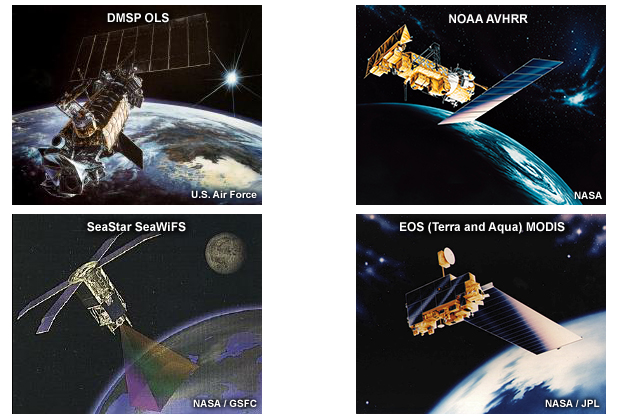
VIIRS represents the culmination of years of experience with both research and operational satellites. The concept came into being as the planned convergence of the capabilities of the Advanced Very High Resolution Radiometer (AVHRR) from the NOAA civilian operational satellites and the Operational Linescan System (OLS) from the Defense Meteorological Satellite Program (DMSP). In addition, VIIRS technology draws heavily from the Earth Observation System (EOS) Moderate Resolution Imaging Spectroradiometer (MODIS), a research instrument that is advancing our ability to observe and understand the earth and its atmosphere. VIIRS also owes a considerable debt to the SeaStar OrbView-2 Sea-viewing Wide Field-of-view Sensor (SeaWiFS). This is an ocean color imager that has given us vital new information about Earth's oceans.
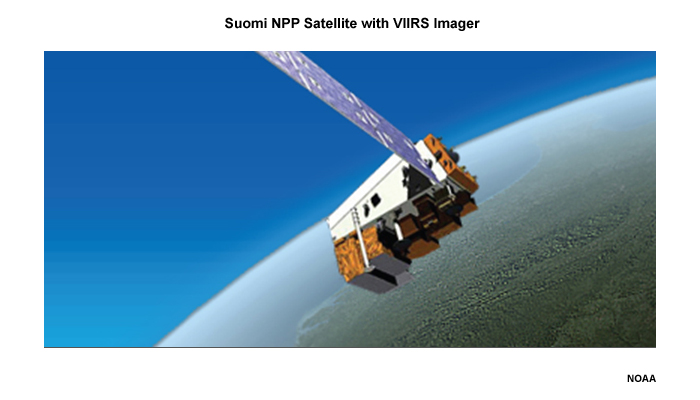
While the initial motivation for a new imager came from AVHRR and OLS, the advanced engineering of VIIRS represents a synthesis of the architectures of MODIS and SeaWiFS.
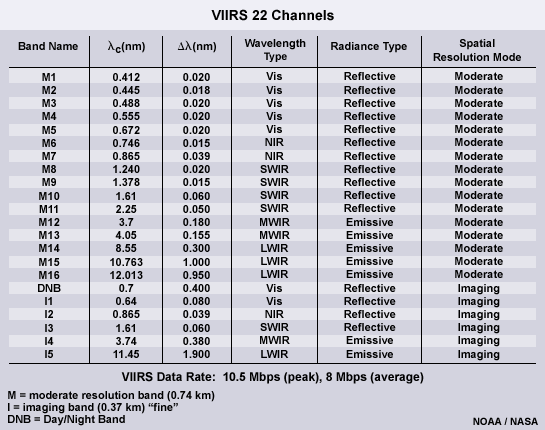
VIIRS has 22 channels meticulously chosen to produce a large array of Environmental Data Records or EDRs. Since we are considering imagery, spatial resolution is the key. The higher the resolution the better the imagery. VIIRS engineers built an instrument that both improves and preserves resolution across the scan.

This module will examine the strengths and the limitations of VIIRS predecessor systems for two important reasons. First, the existing constellation of polar-orbiting imagers is making important contributions to a much improved imaging capability coming online with VIIRS. And second, for several years to come, some of these existing satellites will continue to satisfy a large number of meteorological and environmental needs. The module will also devote important attention to the OLS sensor since online educational materials about it are not readily available elsewhere, and the OLS makes crucial contributions to the sensor suite on VIIRS. Less emphasis will be placed on the AVHRR because materials about it are available from existing materials elsewhere.
After completing the module, learners will be able to:
- Name the important heritage instruments that led to the development of the VIIRS imager
- State the advantages of multispectral imagery in fire and hot spot detection and interpretation
- Use true color imagery to identify surface, atmospheric, and ocean surface features and characteristics
- Discriminate between nadir and edge of scan passes from AVHRR
- Describe the difference between fine and smooth OLS data
- State the advantages of the nighttime visible channel on OLS
- State features that can be seen during no-moon, half-moon, and full-moon illuminations
- Identify features in no-moon, half-moon, and full-moon illuminations
Introduction » Overview » What is Imagery?
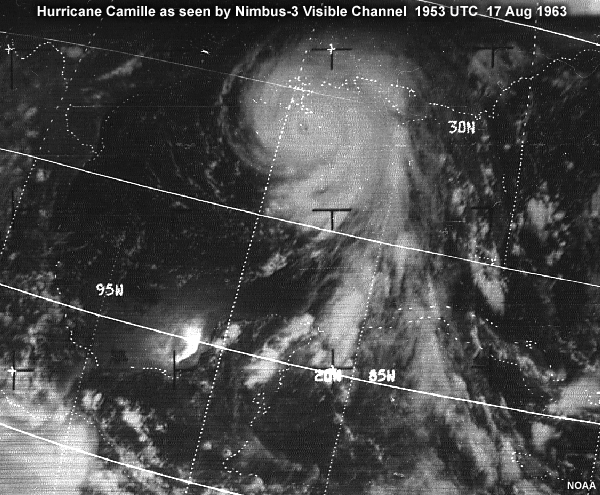
But what is “imagery” exactly? Imagery is used extensively by “eyeball” meteorologists, as opposed to “numerical meteorologists.” Used for forecasting and nowcasting, it is in very high demand by the U.S. Department of Defense in operations worldwide. It is also indispensable to the U.S. National Weather Service, other operational agencies, and private businesses. Increasingly, imagery goes well beyond what forecasters used to call “the satellite picture.” This was usually in black and white, visible and infrared, sometimes fuzzy in appearance, and typically available hours later.

The images from VIIRS will be sharp, colorful, and information-rich depictions. VIIRS will produce spectacular global composites as well as highly zoomed images over mesoscale and even microscale phenomena, like this close-up of a dust storm over western Afghanistan taken by the MODIS imager.
Introduction » Polar-Orbiting Satellite Coverage
Polar-orbiting operational environmental satellites have been flying since the 1960s. As the animation shows, they provide multiple “looks” at all areas of the globe every day. The following pages will show imagery from a number of polar satellite systems that support operational meteorologists, research scientists, and other environmental interests.
Introduction » Southern California Fires: DMSP OLS Nighttime Visible
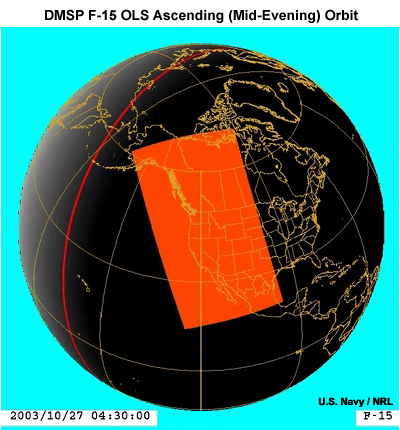
Here is an evening DMSP pass over the West Coast of the U.S.
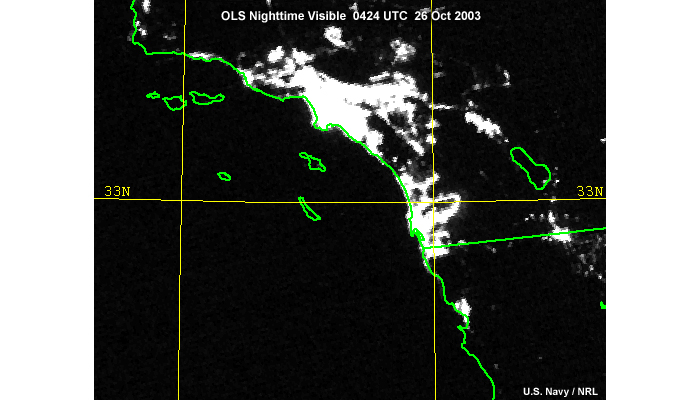
This OLS image was taken at about 9 o’clock in the evening local time showing what appeared to be the usual brilliant lights of the Southern California coastal region. However, this was a night when wildfires raged out of control in the foothills north of Los Angeles to well south of the Mexican border. Don’t be surprised if you can not see them. These fires are very bright but blend in perfectly with the bright city lights nearby.
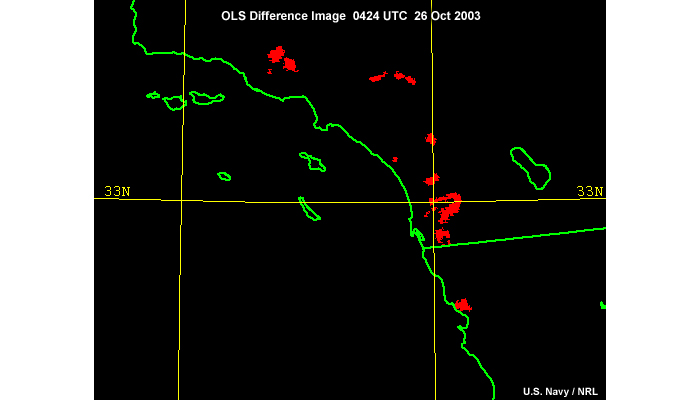
This new image was created by subtracting the first visible image from a fire-free background image taken a few nights earlier. This procedure isolates the fires in red and eliminates lights from cities.
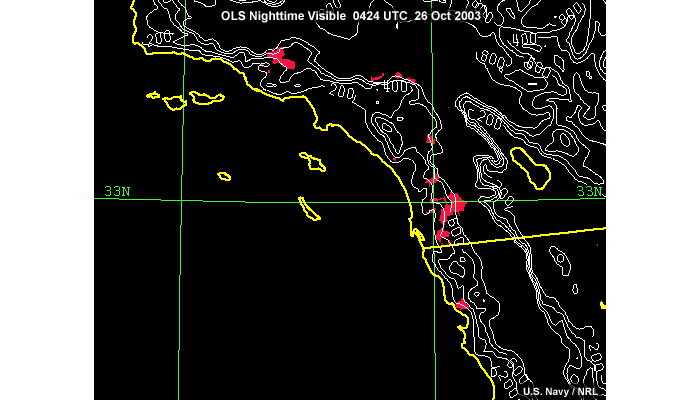
An overlay of elevation contours in white gives us the ability to track fires in areas of complex terrain. This capability will be much improved with VIIRS on board the Suomi NPP and JPSS satellites. The VIIRS imager has higher spatial and radiometric resolution, less noise, and more channels than DMSP. Fire images should be spectacular.
Introduction » Southern California Fires: AVHRR
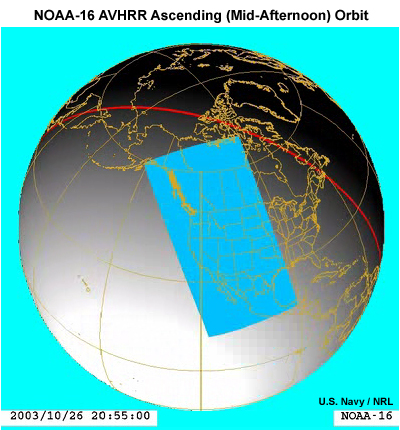
Let’s continue to monitor the progress of the emergency in Southern California, imaged the next day by the NOAA AVHRR on board NOAA-16. This orbiter ascends during the daytime at about two o’clock in the afternoon local time.
The image shows out-of-control chaparral fires fanned by hot Santa Ana winds. Red pixels represent fires in this false-color image. It’s no wonder the fire imaging capability of AVHRR has been such a hit. Emergency managers use these images in near real time to coordinate fire fighting efforts.
Click here or click image to view a high-resolution AVHRR false-color image.
Introduction » Southern California Fires: MODIS
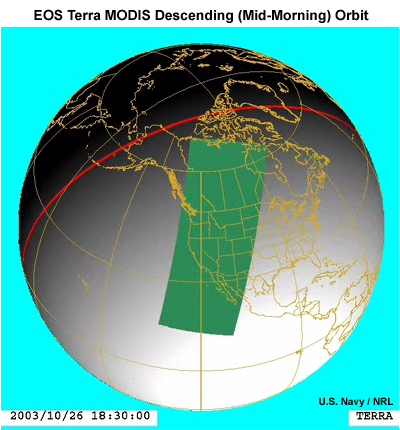
Now look at the improved depiction from the EOS-Terra MODIS imager. Terra passes over the same area at about the same time the previously shown NOAA-16 AVHRR image was taken.
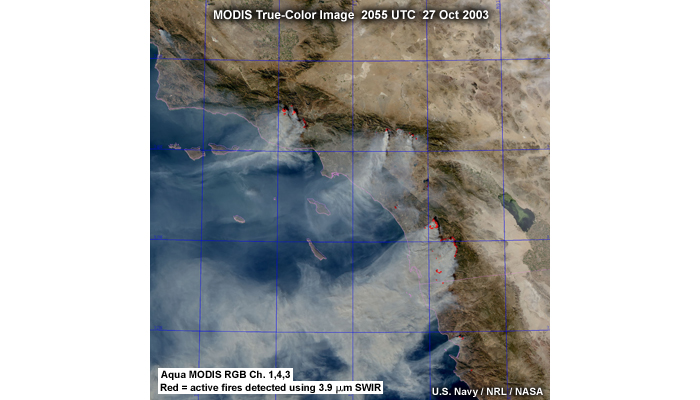
Shown here is a true-color image. Notice that the advanced MODIS capabilities give us sharper detail, more realism, and the ability to see through the smoke. The locations of fires and hot spots, indicated by the red pixels, were added on top of the image.
Introduction » Southern California Fires: MODIS Zoom
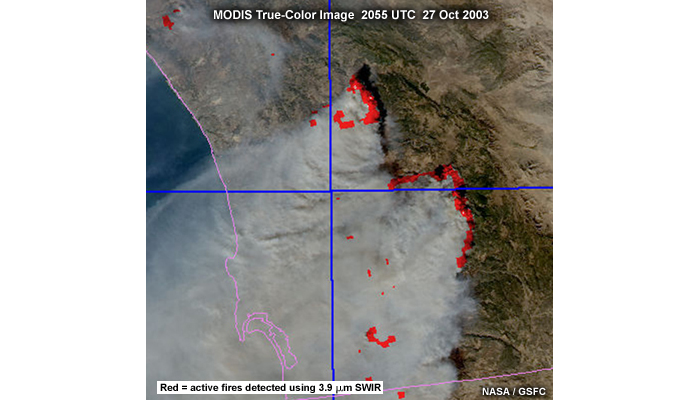
VIIRS brings even further improvement. The depiction of fires, shown as red pixels, will be better in the VIIRS era. Notice the “blockiness” of the fires in this zoom of the previous MODIS image. VIIRS has an improved fire channel footprint one seventh the size of the area seen by AVHRR or MODIS. With the enhanced capabilities of the fire channel, VIIRS can see smaller hot spots and provide more detailed depictions of a wildfire's coverage.
Introduction » Using MODIS/VIIRS for Burn Scar Identification
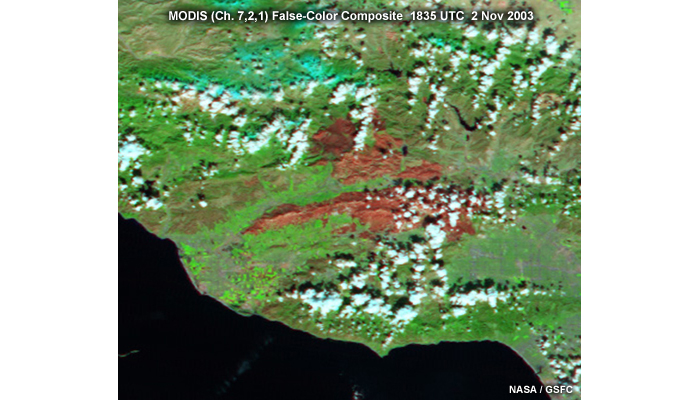
Not only will VIIRS help us see fires. It will also give a detailed look at the burn scars that follow, helping in the rebuilding and restoration phase. Here MODIS gives a preview of this capability several days after brush fires. Burn scars are shown in red northwest of the San Fernando Valley near Los Angeles.
Introduction » Summary
- The VIIRS imager draws on technologies from several imaging instruments including: DMSP OLS, NOAA AVHRR, EOS Terra and Aqua MODIS, and SeaStar SeaWiFS
- VIIRS has 22 channels designed to support a large suite of multispectral products (EDRs) at high spatial resolution
- A constellation of polar-orbiting satellite systems provides global coverage several times a day
- City lights and fires blend together in nighttime visible imagery
- Using a control image, fires can be shown by subtracting out city lights
- AVHRR multispectral false-color imagery shows hot spots, fires and smoke plumes
- MODIS provides true-color imagery using multiple channels in the visible
- Increased spatial resolution of VIIRS will significantly improve fire detection and monitoring capabilities
- VIIRS enhances the capability to monitor burn scars and other land surface features
VIIRS Resolution Improvements
VIIRS Resolution Improvements » MODIS: Three Spatial Resolutions
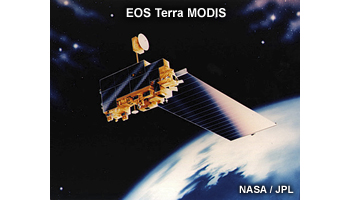
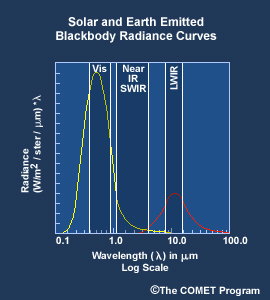

The NASA-EOS MODIS imager provides an important preview of the high spatial resolution capabilities of the VIIRS imager. MODIS has 29 channels at 1000 m resolution from the visible through the longwave infrared.
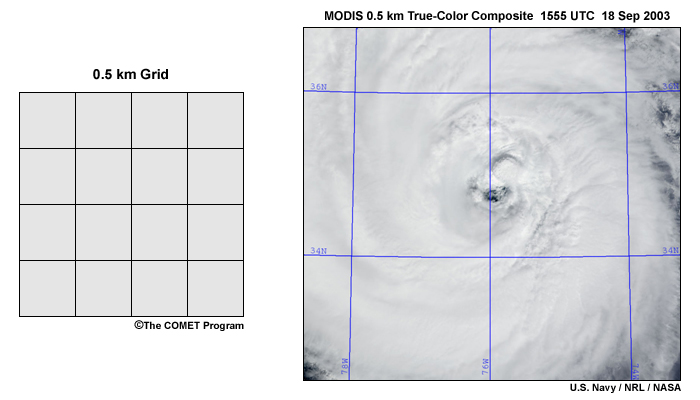
MODIS also has five channels at 500 m resolution extending from the visible to the shortwave infrared.
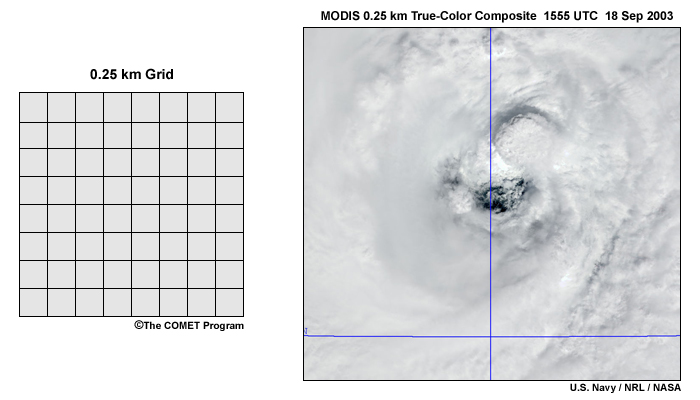
Finally, the MODIS imager has two channels at 250 m resolution, one visible and one near-infrared. At 250 m, we can zoom in on the spectacular detail at the center of Hurricane Isabel.
Except for the Day/Night channel, the VIIRS and MODIS channels are similar. There are some modifications of the exact wavelength ranges used on VIIRS, but VIIRS will offer much of same variety of colorful high-resolution products as seen from MODIS.
VIIRS Resolution Improvements » MODIS: Three Spatial Resolutions » VIIRS Radiometric Performance
VIIRS is built by Raytheon Space and Airborne Systems. The many details of VIIRS engineering and data flow are beyond the scope of this module. The focus in this module is much more on VIIRS imagery and products.
Click chart for a full version, or click here for a scalable PDF version.
VIIRS Resolution Improvements » VIIRS: Two Spatial Resolutions
The 22 imaging channels of VIIRS are divided into two spatial resolutions, “imaging” and “moderate”. The imaging channels have a spatial resolution of about 0.38 km at nadir and the moderate channels have a spatial resolution of about 0.76 km at nadir.

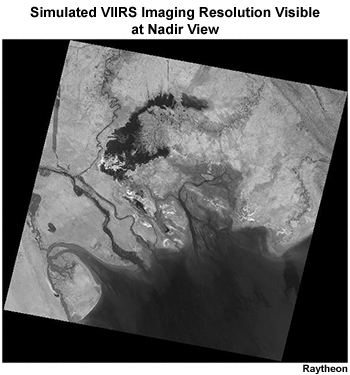
Here is a simulation of the VIIRS visible imaging channel at near nadir viewing angles based on a NASA Landsat image.
A subset of VIIRS’ 22 channels was chosen to have a higher imaging resolution, with similar channels having proven themselves on the AVHRR, MODIS, and other imagers.
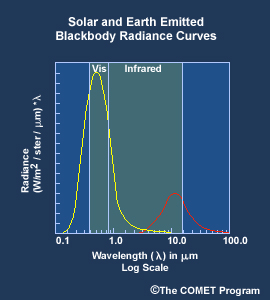

The imaging channels are scattered through the visible and infrared wavelengths. Spectral diversity at high spatial resolution enhances the applicability of VIIRS radiance measurements.
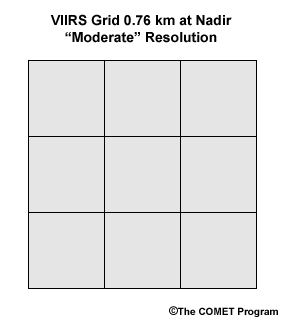
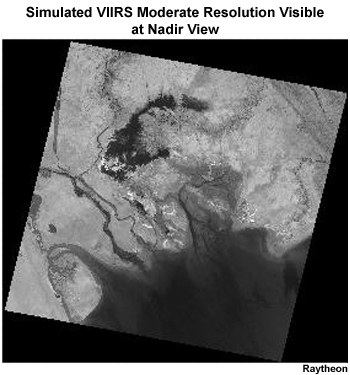
The VIIRS moderate resolution channels, while lower in resolution, complement the imaging resolution channels. Here is a simulated VIIRS image based on Landsat for the 0.64 micrometer visible wavelength.
VIIRS Resolution Improvements » VIIRS: Two Spatial ResolutionsEDR-Driven Performance »
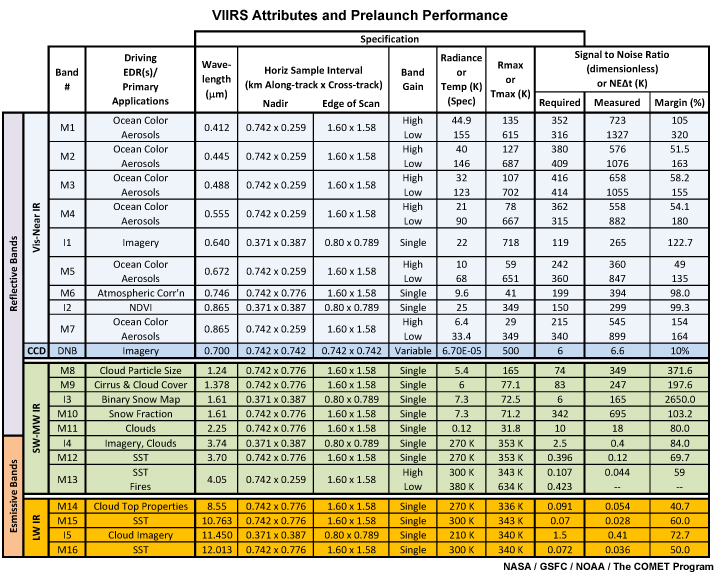
VIIRS has 22 carefully selected channels to produce the environmental data records (EDRs) listed here. Three kinds of channels are found on VIIRS: “I” or imaging resolution channels at high resolution, “M” or moderate resolution channels at a lower resolution, and a Day/Night channel in a category all by itself.
VIIRS Resolution Improvements » Satellite Resolution Grids
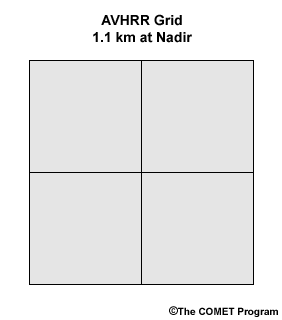
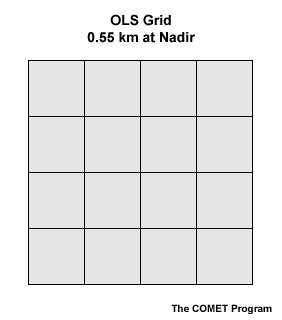
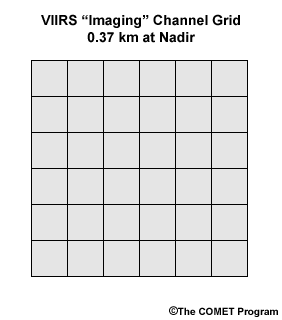
Let's examine and compare the highest resolution possible with AVHRR, OLS, and VIIRS. This sequence of grids illustrates the improvement for viewing at nadir. But as we will see, this is a significant underestimate of the total improvement that comes with VIIRS.
VIIRS Resolution Improvements » AVHRR Contributions to VIIRS Spectral and Spatial Resolution
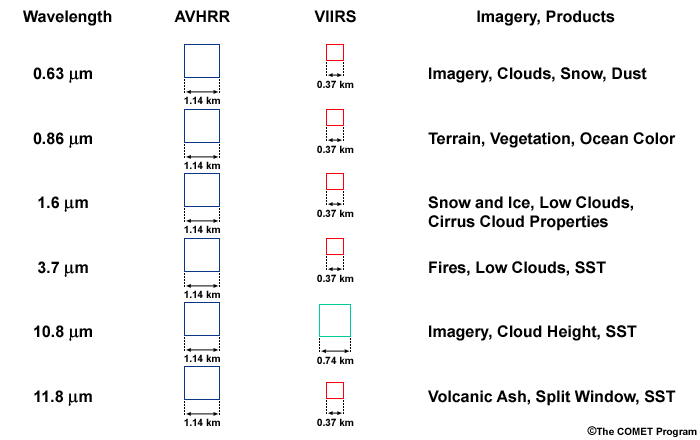
All of the six spectral channels on AVHRR are included on VIIRS at a much higher spatial resolution. The smaller the squares, the higher the resolution and the more detailed the images. Five of the AVHRR channels are becoming VIIRS imaging channels at a resolution of about 0.38 km at nadir. A sixth channel will become a moderate resolution channel.
The AVHRR not only provides high spatial resolution, but fine calibration which is crucial for certain kinds of imagery and derived products. VIIRS radiometric resolution is improved, with 4096 gray shades or levels of independent measurement, vs. 1024 for AVHRR. This will lead to more useful image products and better science. Many products will be available at much higher spatial resolution than with AVHRR, including those used for fire detection, nighttime fog, snow cover, and many other applications.
VIIRS Resolution Improvements » AVHRR Imagery over Italy
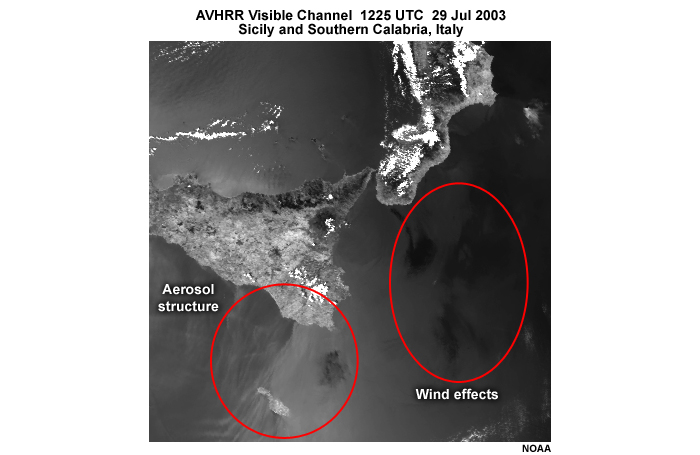
An AVHRR pass over the Mediterranean demonstrates the high-resolution capabilities of this instrument. This AVHRR visible channel image shows tremendous detail over Sicily and the Mediterranean. The image’s 1024 available gray shades help reveal aerosol structure and differences in ocean roughness due to surface winds.
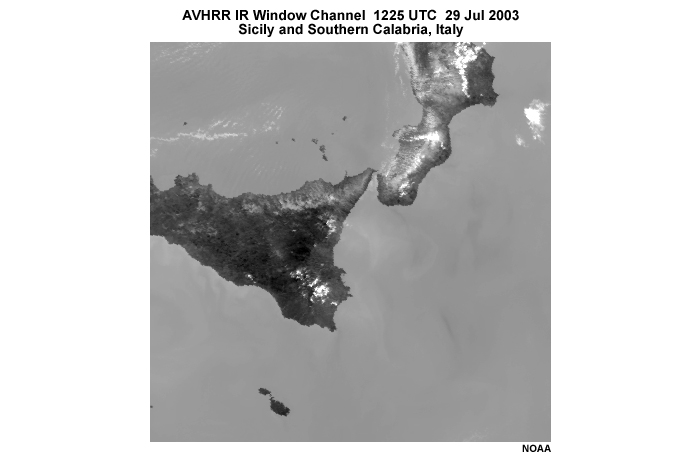
The corresponding infrared image has the same high spatial resolution available in the visible channel.
VIIRS Resolution Improvements » Improvements in Sea Surface Temperature
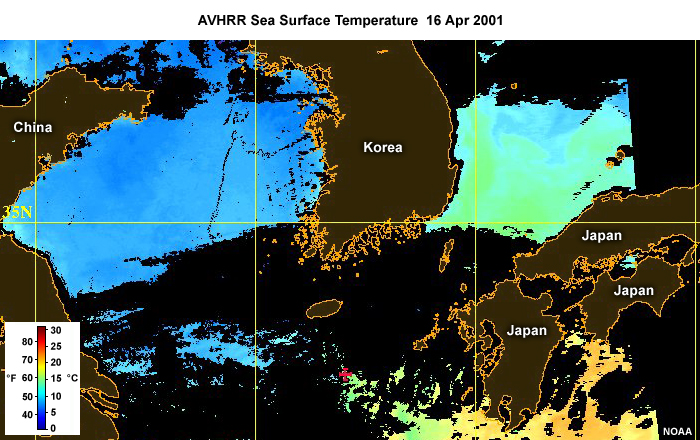
One of the top requirements for polar-orbiting satellites is retrieval of sea surface temperature. There are few environmental variables more important for climate, weather forecasting, recreation, and the ocean environment. AVHRR has been performing this mission for decades on both regional and global scales with accuracies of about one half degree Celsius.
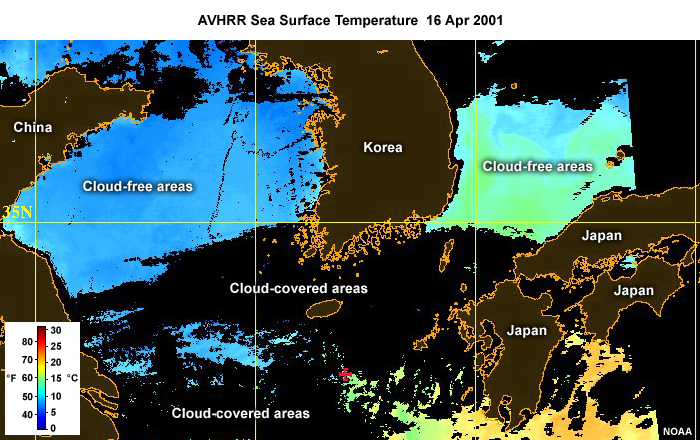
There are two main tasks in the production of sea surface temperature. First, cloud-free areas must be identified since the infrared channels cannot detect the sea surface through clouds. And second, at least two infrared channels are combined to derive sea surface temperature in the cloud-free areas.
In this image the coolest waters are west of Korea in blue. To the east of the Korean peninsula waters are somewhat warmer and shown in green. Warmer still are the waters south of Japan shown in orange. The problem is that so many regions are blacked out due to cloud contamination that the sense of spatial continuity is lost.
Fortunately, in the Suomi NPP and JPSS era microwave imaging instruments including the SSMIS, GCOM-W AMSR-2, and GPM Microwave Imager will serve as companions to VIIRS. These microwave instruments will help fill in the sea surface temperatures where clouds block the VIIRS infrared channels, eliminating most of the troublesome gaps.
VIIRS Resolution Improvements » Summary
- MODIS has 29 channels at 1000 m, 5 channels at 500 m, and 2 channels at 250 m resolution from the visible to the infrared
- VIIRS has 17 channels at 0.76 km and 5 channels at 0.38 km resolution
- All six spectral channels on AVHRR are on VIIRS at higher resolution
- VIIRS and microwave imagers on complementary polar-orbiting satellite missions will work together to help minimize gaps in sea surface temperature measurements due to clouds
DMSP Contributions
DMSP Contributions » OLS Direct Readout: Fine vs. Smooth Mode
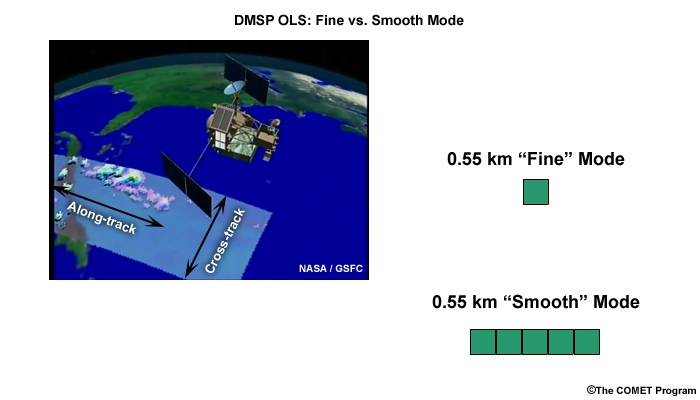
Looking at the DMSP OLS imager operating in direct readout mode can reveal some important aspects of the spatial resolution in the data. The satellite sends data to the earth in one of two modes, either fine/high spatial resolution mode at about one-half kilometer, or smooth/low spatial resolution mode. Only one channel, visible or longwave infrared, is sent in fine mode in order to conserve transmission bandwidth.
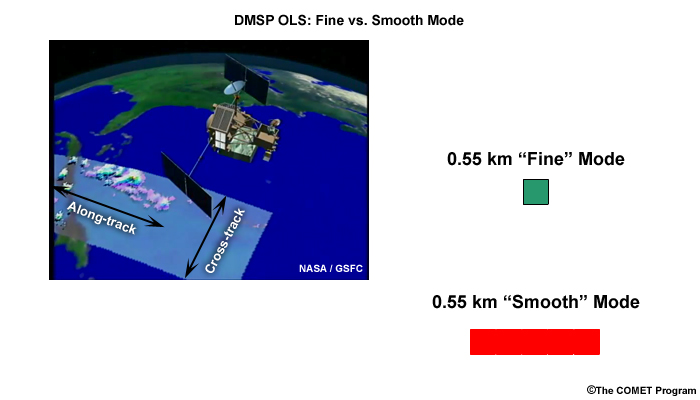
To produce smooth pixels, onboard processing averages five pixels in a row to make long rectangles. These smooth pixels have the same dimension as the fine in the along-track direction, but appear stretched by a factor of five in the cross-track direction.
DMSP Contributions » OLS Direct Readout: Fine vs Smooth Mode Selection
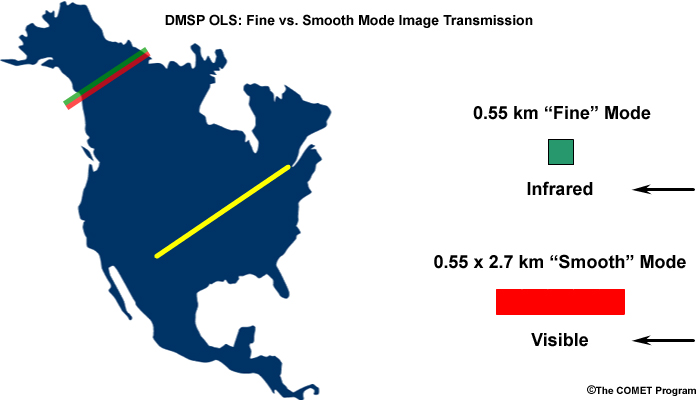
The choice of fine vs. smooth imagery can change depending on how the satellite is programmed. For a particular location, the satellite might be ordered to transmit the infrared as fine and the visible as smooth. In that case, analysts viewing the data would see high-resolution “fine mode” infrared images, but lower resolution visible images.
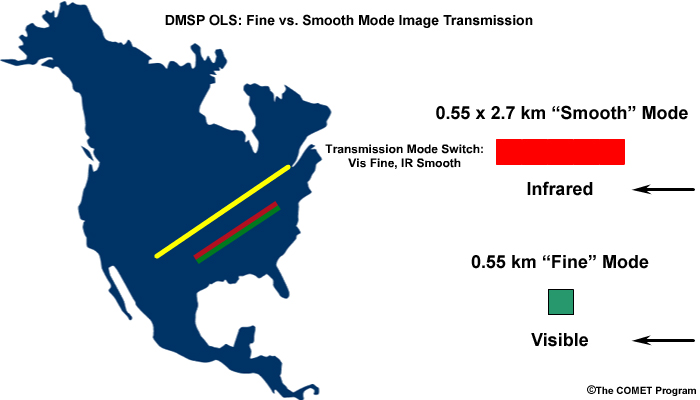
Making the choice of “fine” and “smooth” modes for the two channels is up to central planners trying to maximize the effectiveness of the data stream at any one place.
DMSP Contributions » OLS Direct Readout: Fine vs. Smooth Mode Selection » Archived OLS Data
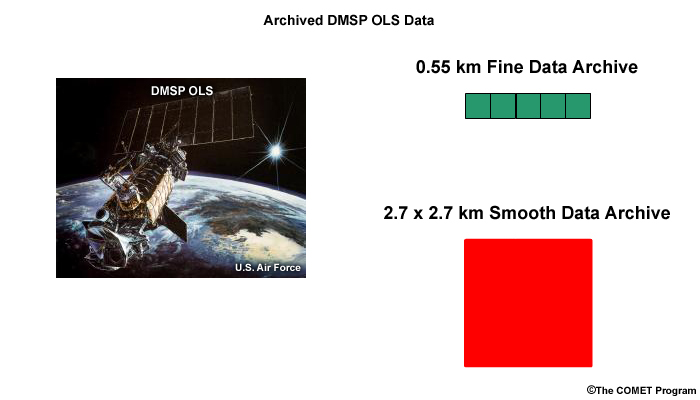
There is a second kind of DMSP OLS data configuration that is stored on the satellite rather than transmitted in real time to ground stations. This second mode is later transmitted to the Air Force Weather Agency (AFWA) in Omaha, Nebraska and archived at the National Geophysical Data Center (NGDC) in Boulder, Colorado. The fine resolution is the same as before. But unlike the direct readout, the smooth pixel data is degraded in both along- and cross-track dimensions, resulting in even smoother images.
DMSP Contributions » OLS Smooth and Fine Data over the Mediterranean

Here is an example illustrating the difference between smooth and fine imagery. Look at the area along the east coast of Spain and over the Mediterranean with the OLS IR channel in smooth mode. The image at 2.7 km resolution is so coarse that it’s almost impossible to distinguish the island of Ibiza from the surrounding sea surface. You can also see individual pixels.
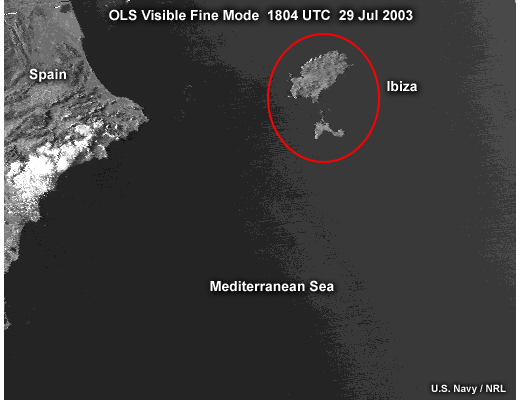
Now let's switch to the fine mode visible image at 0.55 km resolution. Notice how much sharper the detail is.
But there is a disadvantage with the fine mode visible data. In order to transmit the large amount of data required to produce high-resolution imagery, the system economizes by sending the information in only 64 levels of gray. This reduction in the number of available gray shades causes features of relatively uniform brightness to appear as one shade of gray. For example, notice that the water off the Spanish coast appears in only three shades of gray. This limitation of the OLS is being replaced by a much improved capability with VIIRS. Instead of only 64 available gray shades, VIIRS has an astounding 4096 gray shades to display.
DMSP Contributions » OLS Smooth and Fine Data over the Mediterranean » Fine vs. Smooth in the Nighttime Visible Channel
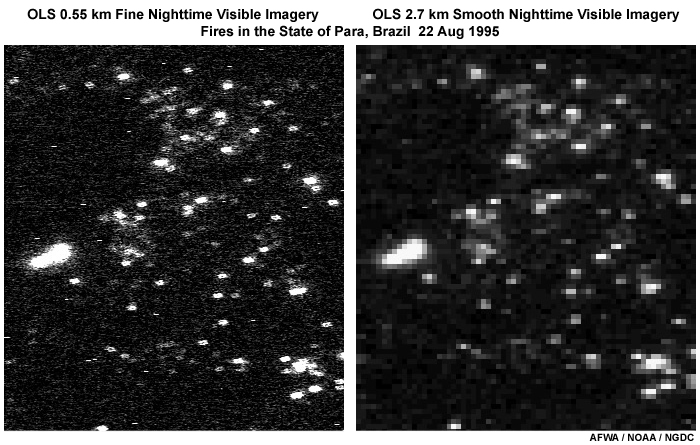
The distinction between fine and smooth imagery that we discussed earlier also appears in the nighttime visible channel. Here, for example, is a comparison between the appearance of cities in a fine vs. a smooth image. The same light sources can be seen in both. But in the smooth image it’s difficult to distinguish individual cities. With the enhanced VIIRS Day/Night channel, imagery will improve significantly beyond what is shown in the OLS on the left side.
DMSP Contributions » OLS Viewing Dust over the Arabian Peninsula
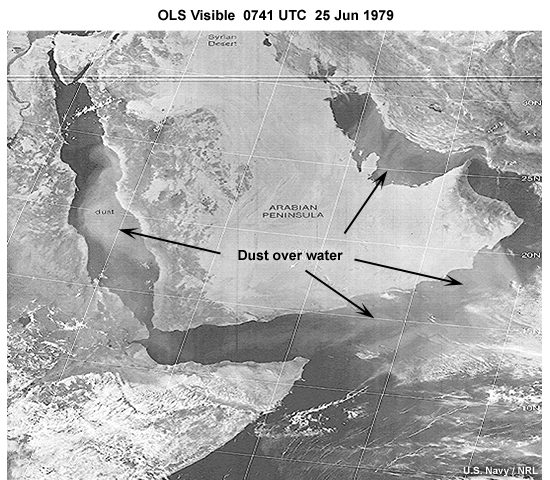
Now let”s pretend that a time machine has transported us back to the year 1979, before many of today’s young weather forecasters and scientists were born. A severe dust outbreak originating over the Arabian Peninsula extends to water bodies on three sides, as seen by this OLS visible image. Used as a training example in one of the first manuals to describe suspended and blowing dust from a space observation perspective, it does an excellent job of showing dust over water. But because dust tends to blend in with the desert background, you might think that there is no dust over land.
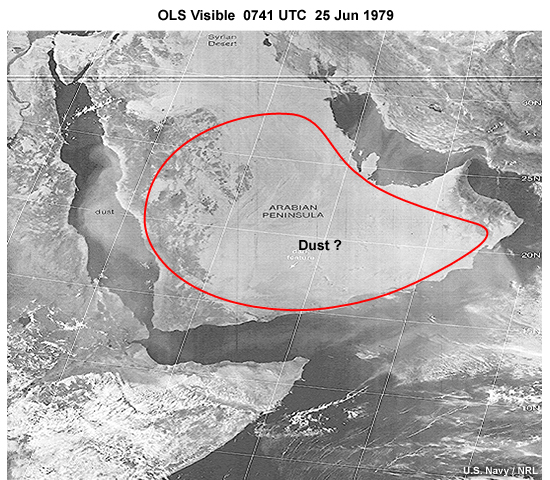
On the contrary, over Saudi Arabia we are looking directly at plumes of thick dust, but just aren't aware of it!
DMSP Contributions » MODIS Dust Product with NWP Model Winds

Coming back to the present, an EOS-Aqua overpass previews the VIIRS capability in this multispectral view from the onboard MODIS imager. Here we are able to see suspended and blowing dust over both land and sea. Thick dust is pink. Mesoscale winds from a short-term numerical forecast add additional information. Notice, for example, that northerly winds over the Arabian Gulf are transporting the dust well south of the source region.
DMSP Contributions » Summary
- OLS fine and smooth imagery have the same resolution in the along-track direction, but smooth imagery is averaged over five pixels in the cross-track direction
- OLS can only transmit fine imagery for one of its two channels at one time
- If visible data is sent in fine mode, IR data must be sent in smooth mode
- Increased bit depth (4096 gray shades per pixel) significantly enhances the ability of VIIRS to distinguish features when compared to OLS
- Multispectral MODIS products that highlight dust will be available from VIIRS at higher spatial resolution
Edge-of-Scan Effects
Edge-of-Scan Effects » Introduction
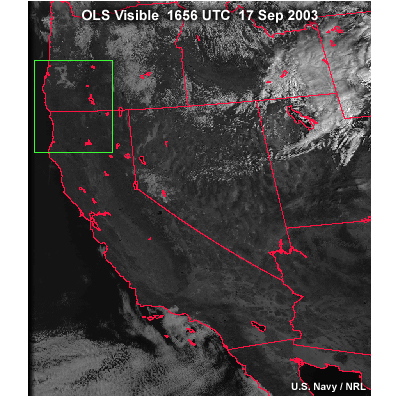
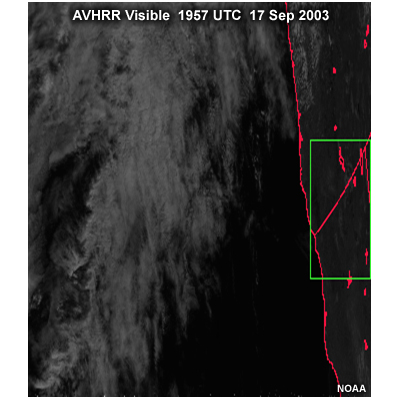
Before we can complete our understanding of VIIRS, we need to revisit the DMSP OLS, which has an intriguing feature unique among weather satellites. Shown here are two visible images, one from OLS fine taken over the Pacific Ocean and the other from NOAA AVHRR taken over the western United Sates. Notice that the images overlap slightly over the northwestern United States. Both data sets are often called high-resolution, which is for the most part an accurate assessment, but something interesting happens at the edge of scan as we'll see.
Edge-of-Scan Effects » OLS and AVHRR at Edge of Scan
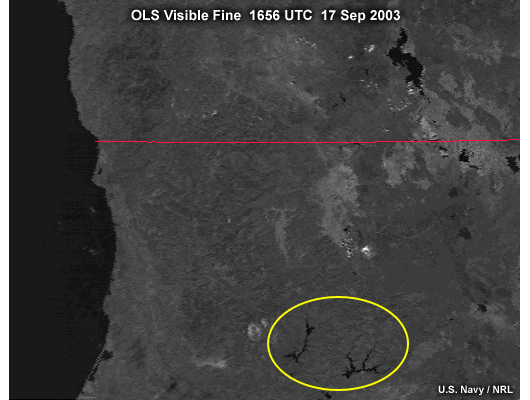
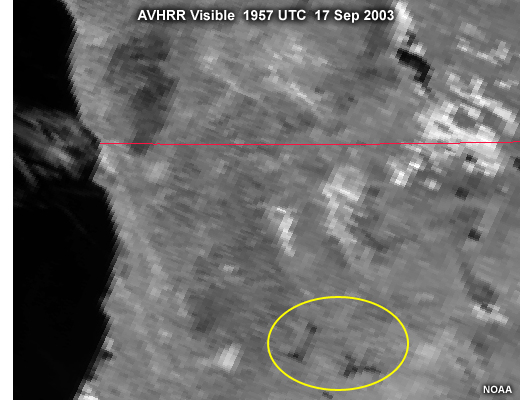
Compare these two co-registered zoomed in areas from each of the passes in the region of overlap. Notice how the OLS image retains its sharpness at the edge of the scan while the AVHRR pixels become very fuzzy. Look for example, at the level of detail apparent for the reservoirs in the southern portion of the image.
Edge-of-Scan Effects » Dramatic Spatial Resolution Improvements
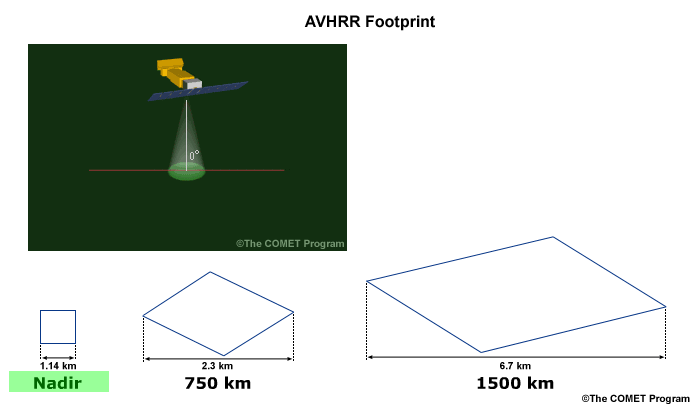
Image quality is a function of the satellite scanning strategy. The following graphics depict individual footprints from several satellites beginning with a nadir view,

then halfway out toward the edge of scan,
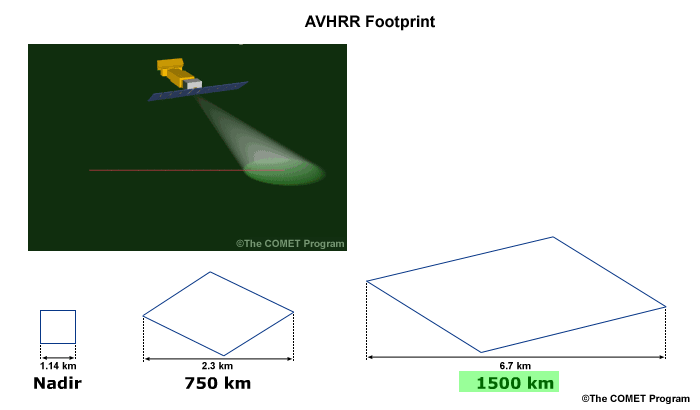
and finally at the edge of scan.
For AVHRR, high-resolution footprints at nadir degrade rapidly to low-resolution data toward the limb. The growth in pixel size is huge. No wonder the AVHRR images we looked at were so degraded. MODIS and SeaWiFS imagery have the same degradation factor as AVHRR.

The OLS engineering produces a much smaller degradation toward the edge of scan, and hence, the pixels are still high resolution and details in the image are preserved.
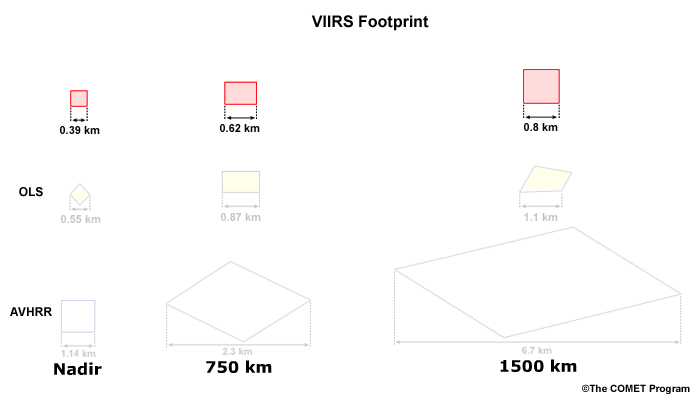
The advanced VIIRS engineering borrows this concept from OLS to avoid the pixel growth inherent in AVHRR, MODIS, and SeaWiFS. Notice the minimal growth of the fine resolution VIIRS channels. VIIRS preserves image quality across the scan.
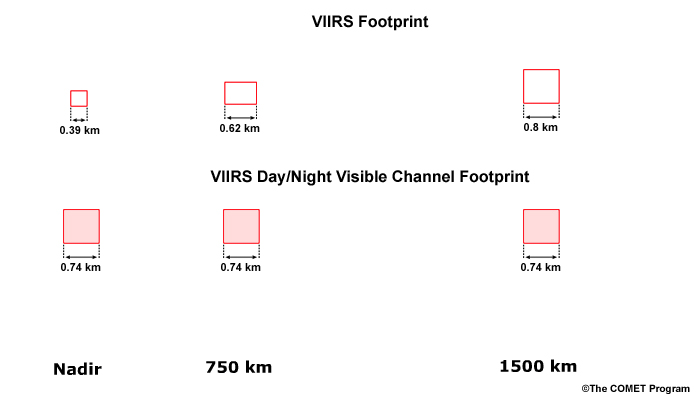
Finally, let’s consider the VIIRS Day/Night channel. It does not expand at all! This is one of several reasons that nighttime visible images from VIIRS are superior to the current DMSP OLS.
Edge-of-Scan Effects » OLS and AVHRR at Edge of Scan over Hawaii
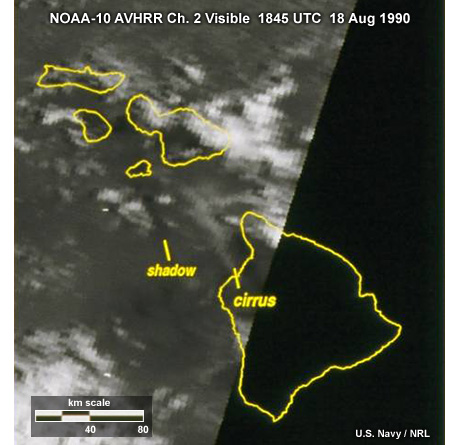
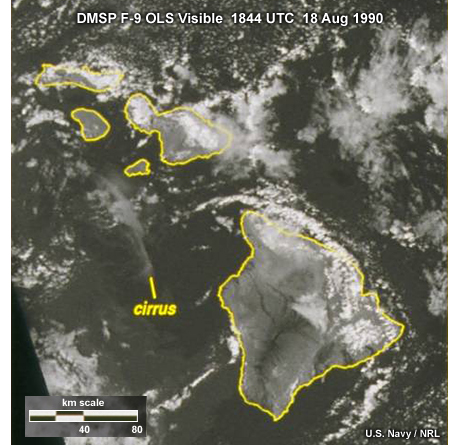
Let’s look at another pair of examples imaged only moments apart. The OLS visible image has sharp cloud detail at the edge of scan, whereas the AVHRR edge-of-scan image shows cloud features that are blurred. Clearly, the OLS has a big advantage in these edge-of-scan regions.
Edge-of-Scan Effects » Pixel Growth at Edge of Scan
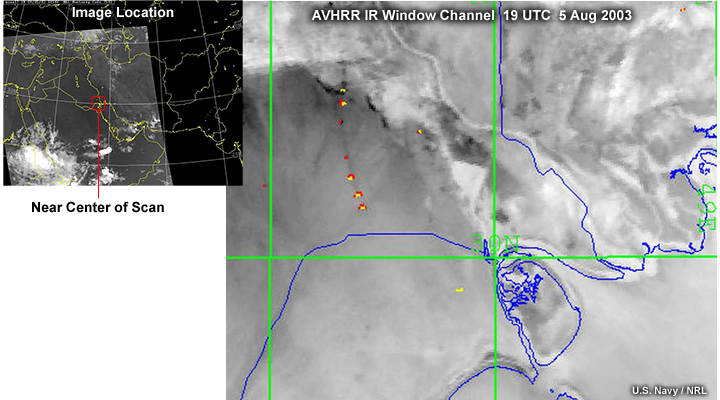
The growth of pixels at the edge of scan for imagers like AVHRR and MODIS can have a profound effect on derived products, not just on simple single-channel imagery. Let’s look, for example, at this case of nighttime gas flare detection over Kuwait using the AVHRR. The hot flares, that are at the center of the scan, are shown in red.
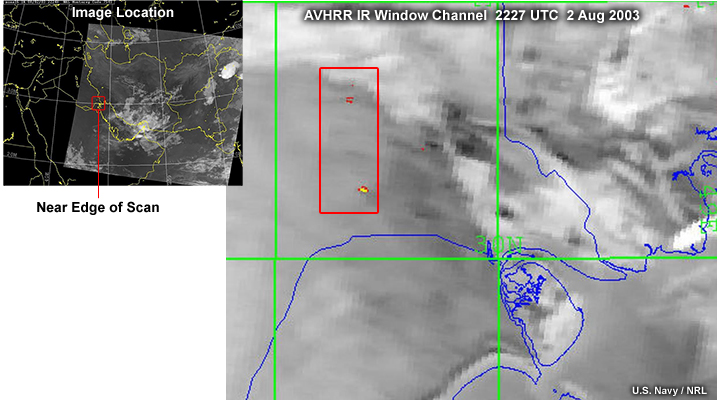
But on a night with the same set of gas flares burning, significantly fewer flares are detected toward the edge of scan. Don’t get the false impression that the gas flares are being turned on and off based on successive images. Seeing fewer flares or hot spots in this case is mostly the result of edge-of-scan effects so that smaller, less intense flares can no longer be adequately resolved.
Edge-of-Scan Effects » AVHRR vs. VIIRS Visible Simulations
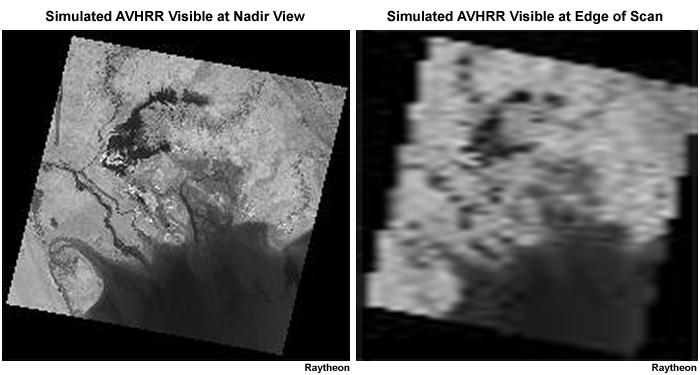
Here are simulations of what VIIRS should look like compared to AVHRR. Based on very high-resolution Landsat data, these visible images simulate the appearance of the northern Arabian Gulf in a nadir versus edge-of-scan view for AVHRR. Notice how the edge-of-scan view becomes almost completely useless, especially if an analyst wanted to examine the intricate waterways within this region.
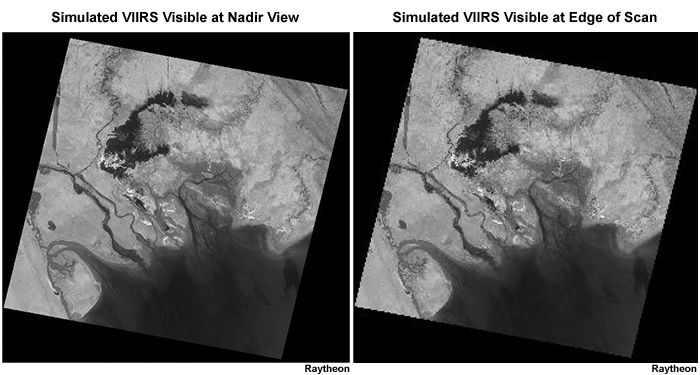
Here we look at the kind of improvement expected with VIIRS. A sharp eye can still spot minor degradation from nadir to edge of scan. But to many users, the images here will look identical. For example, both images are almost equally good at examining the delta region. Therefore, users wanting detail will not have to toss out VIIRS passes simply because their area of interest lies near the edge of the pass. Image quality remains high across the entire swath.
Edge-of-Scan Effects » Summary
- AVHRR image quality degrades near the edge of scan
- The area of an AVHRR footprint is 28 times larger at edge of scan than at nadir
- The area of an OLS footprint is 4.5 times larger at edge of scan than at nadir
- VIIRS footprint geometry improves on OLS
- The VIIRS day/night channel maintains the same resolution across the entire swath
- Edge of scan blurring has a negative impact on image products
- VIIRS preserves resolution across the entire swath
True- and False-Color Imagery with VIIRS
True- and False-Color Imagery with VIIRS » Introduction: SeaWiFS and MODIS Contributions
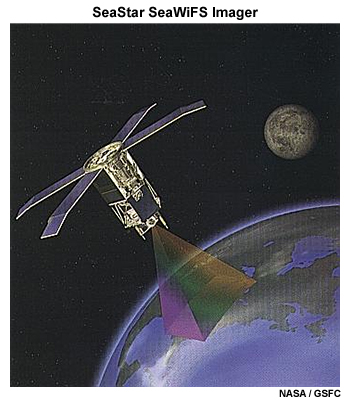
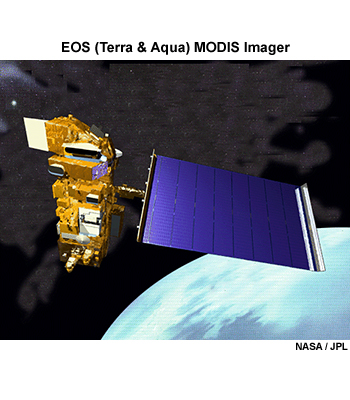
Let's examine the contributions of SeaWiFS and MODIS. These two systems have accomplished two major tasks in preparation for VIIRS. First, components of the engineering from each have been combined to form the advanced VIIRS architecture. And second, each has multispectral channel suites crucial for the construction of advanced imagery. In the case of SeaWiFS, the imager has been used to produce ocean color and aerosol products while MODIS has been used to demonstrate atmospheric, ocean, and land-use products.
True- and False-Color Imagery with VIIRS » True-Color Enhancement

Color will add an important dimension to VIIRS imagery. Using MODIS and SeaWiFS, we can examine some of the ways color can enhance the usefulness of image products.
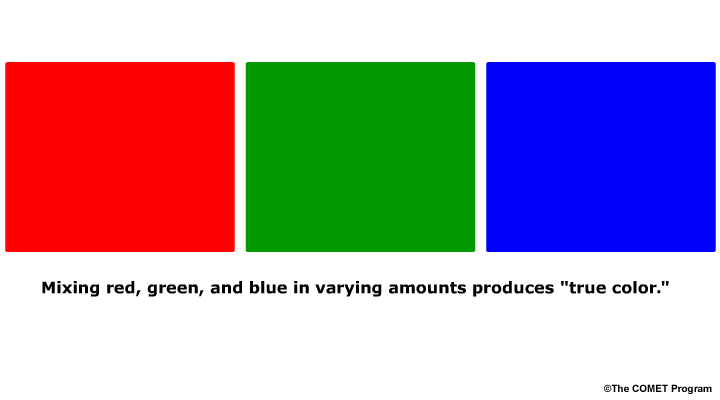
True-color imagery mimics what the human eye can see and is formed by combining colors as the diagram shows here. Individual visible channels are traditionally displayed as black and white imagery.

The reflected light shown in a visible image, however, represents a distinct portion of the visible spectrum ranging from the shorter (blue) wavelengths to the longer (red) wavelengths. The MODIS imager, like VIIRS, has three visible channels that correspond closely to the red, green, and blue wavelengths within the visible spectrum.
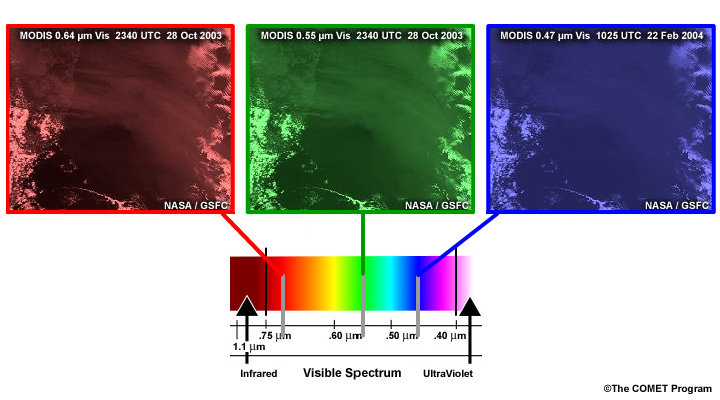
Each of these channels can be processed so that one color range is assigned to each of the three wavelength regions. Combining all the color ranges produces what is known as “true-color” imagery.
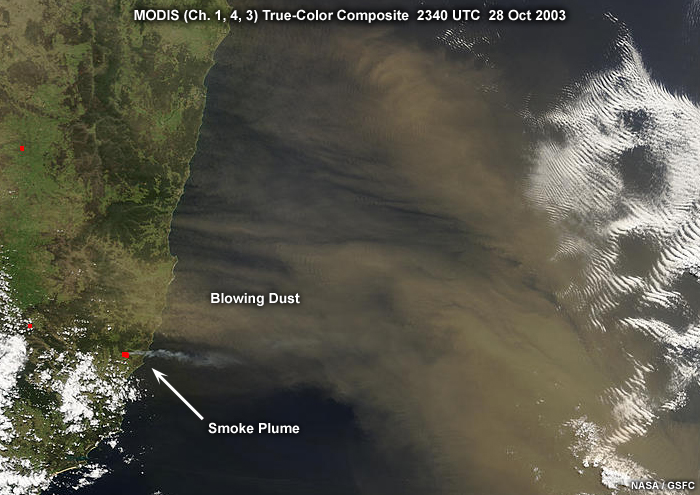
The first example shown here is of blowing dust and smoke being advected eastward off the east coast of Australia. Notice how much easier it is to distinguish the smoke plume from the large area of blowing dust in the true-color image. The suspended dust particles take on a light brownish appearance in the true-color composite because they reflect more light at the longer visible wavelengths, the red and green regions of the spectrum. Smoke from burning vegetation, on the other hand, appears relatively white, reflecting the red, green, and blue components of visible light in relatively equal amounts. Recall that when you combine red, green, and blue in equal amounts, the result is white. Clouds are also easily separated from the suspended dust in the true-color image, and appear white for much the same reason. A small group of red pixels indicating hot spots or fires appears at the western end of the smoke plume. These were inserted after the channel compositing took place using information from the thermally sensitive shortwave infrared channels on MODIS.
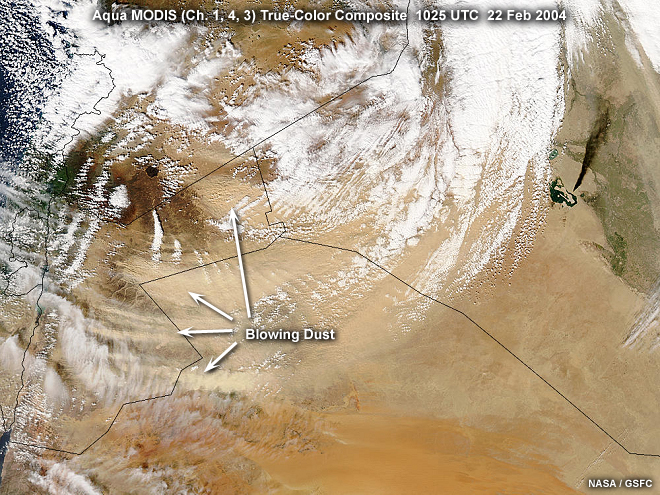
The second example highlights a dust storm over Jordan, Iraq, Saudi Arabia, and an oil fire in Iraq. Notice how effectively the true-color image distinguishes blowing dust and clouds when compared to the same scene in the single-channel black and white images.
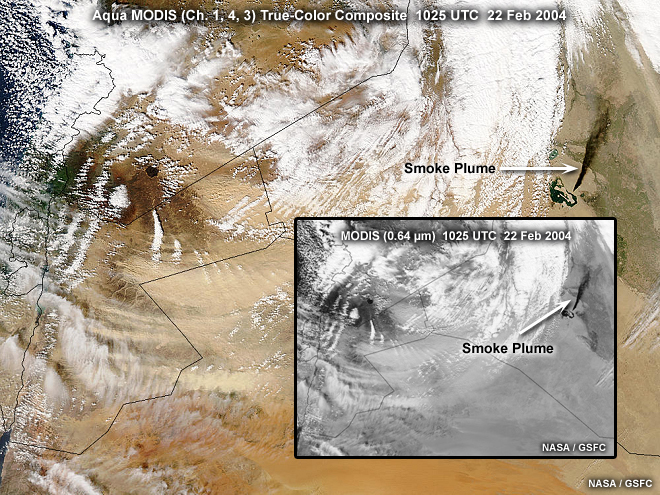
The smoke plume associated with an oil fire in Iraq appears black in both single-channel visible and true-color imagery, since oil smoke is very effective at absorbing light across the visible spectrum.
True- and False-Color Imagery with VIIRS » Polar Eddies in the Davis Strait
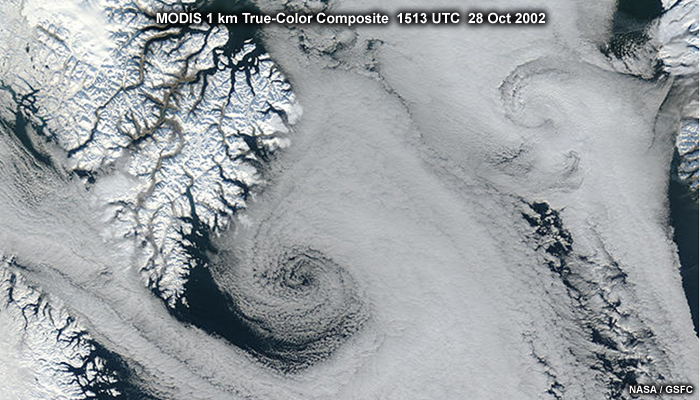
Using a MODIS true-color image we can examine some polar eddies in the Davis Strait between Greenland and Canada. These eddies are often the first stages in polar low development and can be shown in great detail using MODIS true-color imagery. Improved communications and data processing for future polar-orbiting satellites will mean that these features can be imaged and tracked closer to real time, giving forecasters access to more timely information.
True- and False-Color Imagery with VIIRS » Hurricane Isabel at Different Resolutions: GOES Imager
For an example of what VIIRS offers in terms of improved spatial resolution, let’s first look Hurricane Isabel with some GOES imagery. The images are in black and white since true color is not available with the current GOES. The highest possible resolution from GOES is with the 1-kilometer visible channel as Isabel makes landfall in North Carolina. The loop gives you a penetrating view of the storm, but what if you want to go in even closer?
True- and False-Color Imagery with VIIRS » Hurricane Isabel at Different Resolutions: AVHRR
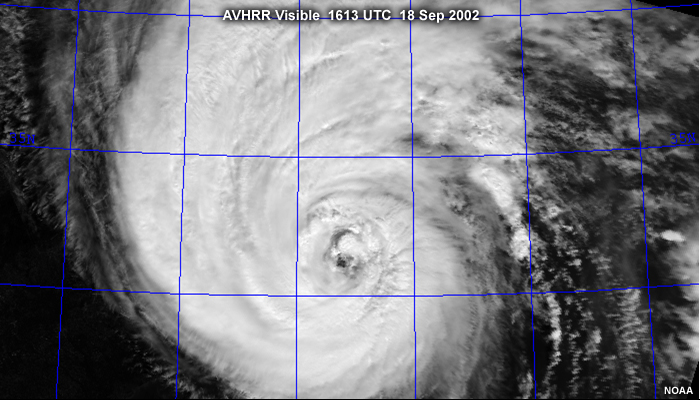
The NOAA AVHRR instrument also provides detailed images, but still the maximum resolution is limited to about 1 kilometer. Like the current GOES, AVHRR is incapable of true-color imaging. What can we do if we really want to see inside the eye of the storm?
True- and False-Color Imagery with VIIRS » Hurricane Isabel at Different Resolutions: MODIS and VIIRS
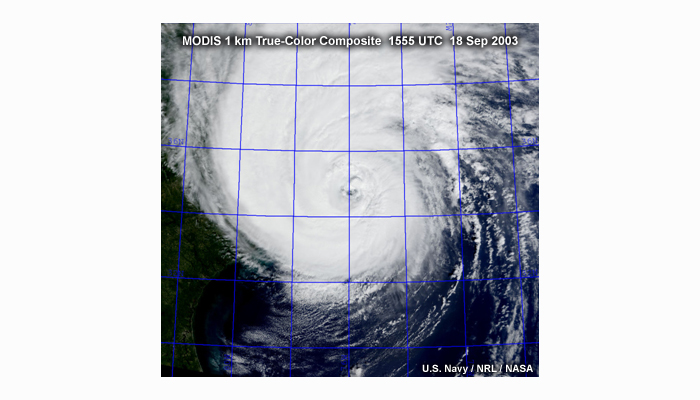
As the EOS Terra satellite flies over the storm we get a preview of VIIRS true-color capability. Let’s start with a 1-kilometer resolution view similar to what we saw from GOES and AVHRR.
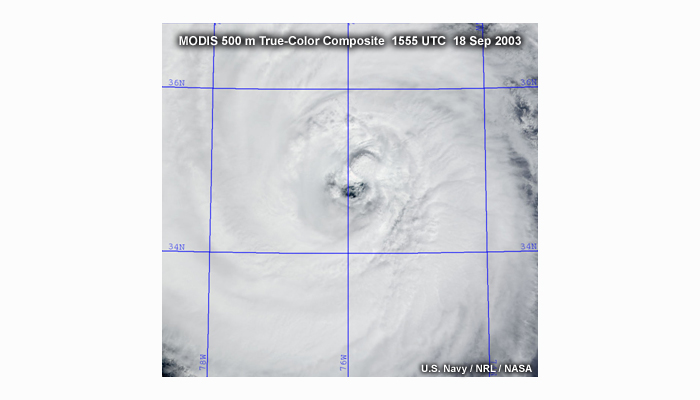
Now let’s go to a 500 m resolution view, comparable to the fine mode visible channel of the DMSP OLS. For many years, this was by far the highest spatial resolution you could get from a weather satellite. But now we can exceed that.
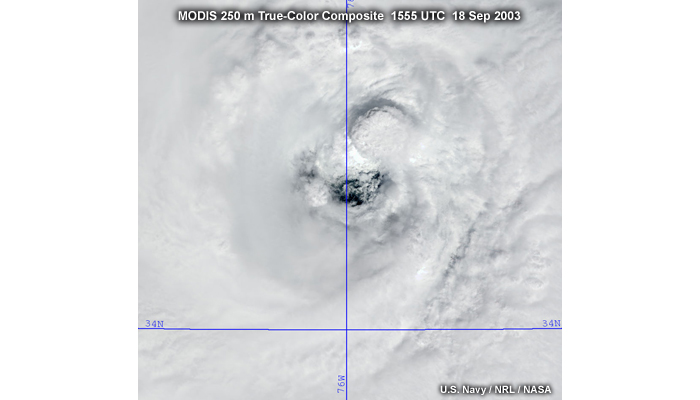
Let’s go on to the 250 m spatial resolution of MODIS. This MODIS image previews the VIIRS capability to create high-resolution true-color imagery, similar to what an airborne hurricane hunter would see flying into the storm’s eye.
True- and False-Color Imagery with VIIRS » Combining True Color and High Resolution: Bangladesh Coastline
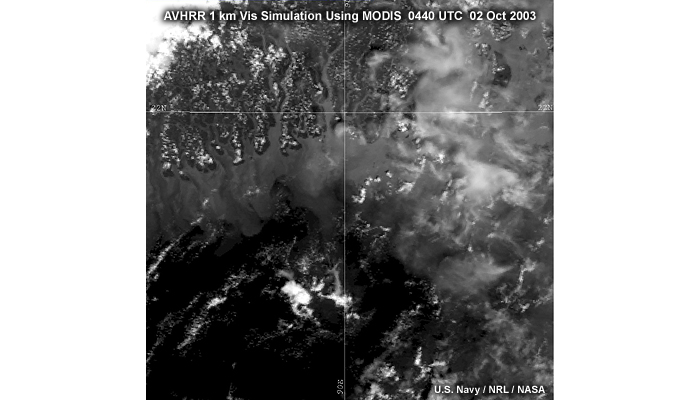
Let’s examine the combined effect of high spatial resolution and true-color capability in MODIS imagery. To illustrate a point, we will degrade the MODIS resolution to 1 kilometer in order to get a black and white image like the AVHRR or OLS would produce. The image shown is a visible close-up over Bangladesh. But a first-time observer unfamiliar with this part of the world might be pretty baffled. What’s water, what’s land, what’s cloud? In short, what’s what in this jumble of gray shades?
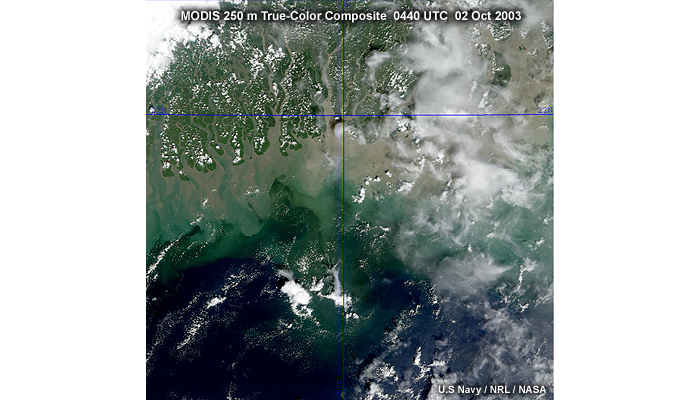
In this second image two things are better: it’s now true color, and it’s also high resolution at 250 meters. Notice how information in the scene now stands out. We can see, for example, heavy sedimentation in the coastal waters, ocean sunglint in blue in the southeast, and cumulus cloud fields. Shadows also suddenly jump out. In the black and white product it was hard to tell clouds from the surface in the northwest. But clouds are white in true color so that distinguishing them from the surface becomes much easier.
True- and False-Color Imagery with VIIRS » Combining True Color and High Resolution: San Diego Coastline
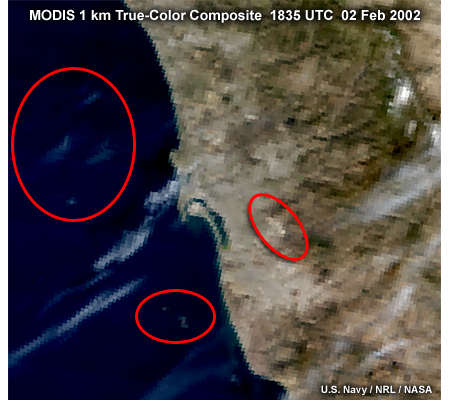
Now let’s look at some high-resolution multispectral imagery over the San Diego area of southern California. In the 1-kilometer image look at the features within the ovals. It’s hard to know exactly what they contain.
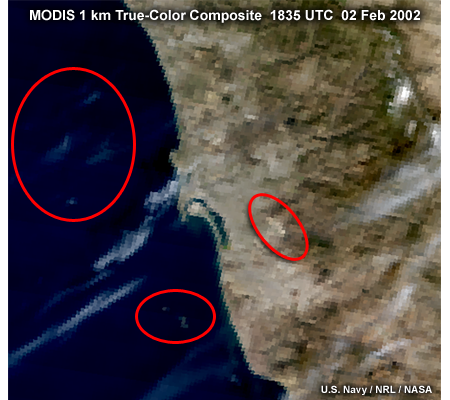
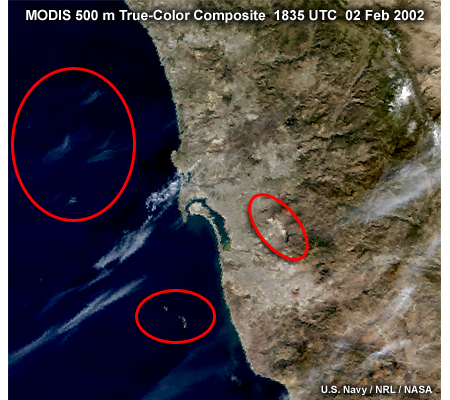

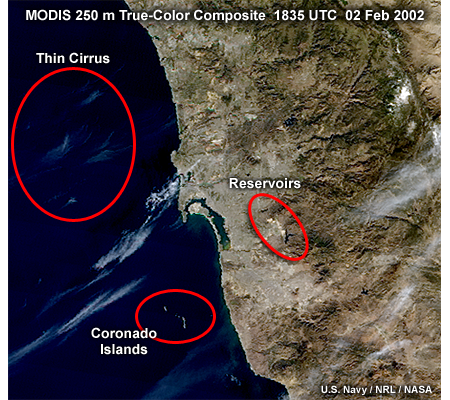
But if you now look at the same area at 500 meter resolution, and then 250 meter resolution, everything comes into focus. The northern oval contains thin, wispy cirrus. The southern oval over water contains islands. And the oval over land contains two reservoirs.
True- and False-Color Imagery with VIIRS » MODIS Monitoring of Volcanic Ash
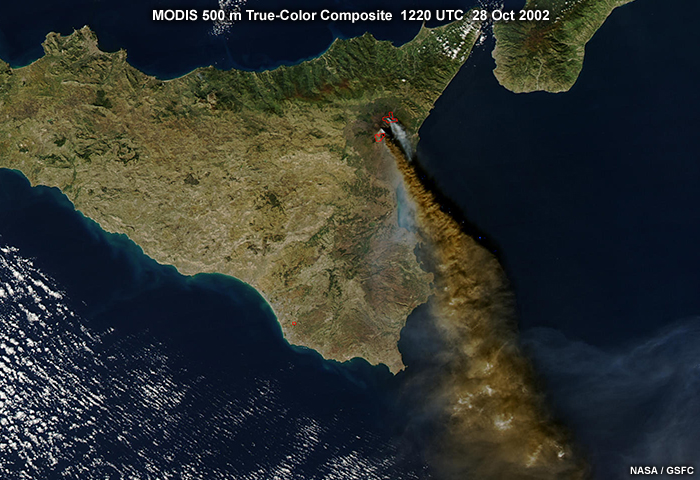
The monitoring of volcanic ash has become a crucial application for satellite remote sensing. Ash damages jet engines, which can cripple even the largest airplanes, and ash near the surface has significant impacts on human health and a variety of activities. Here is a MODIS true-color image of Sicily in the Mediterranean Sea taken during an eruption of the Mt. Etna volcano. Red outlines mark the locations of the actual eruptions as detected by the MODIS shortwave infrared channels, which are sensitive to hot spots.

Notice that there are actually two volcanic plumes of different colors which merge offshore to the south. Often, the 11- and 12-micrometer channels, referred to as the “split window” channels, are used for 24-hour monitoring of these plumes. VIIRS, with its improved spatial and spectral coverage, will lead to the development of more advanced ash detection products that further improve monitoring of volcanic eruptions.
True- and False-Color Imagery with VIIRS » MODIS Imaging of Fog and Low Clouds

AVHRR brought a major advance in the detection and analysis of low clouds and fog at night. Scientists developed low cloud algorithms using channels never intended for that purpose. For example, the 3.7-micrometer channel was placed on the imager for sea surface temperature analysis and not cloud detection. Here is how the fog-low cloud product works using MODIS data. In this nighttime infrared image high clouds show up easily and are highlighted in blue and green shades. But where are the low clouds? Knowledge of where low clouds are located is crucial for a variety of applications. Indeed, there are low clouds in this scene, but their temperature closely matches the temperature of the land and sea surface background, and as a result they in effect disappear.
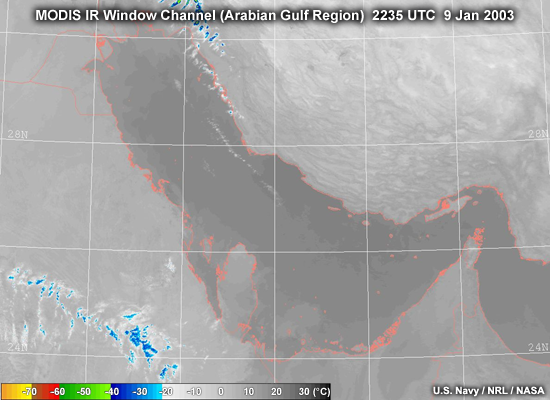
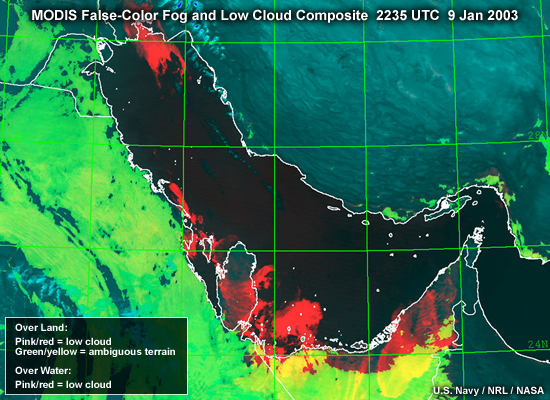
The fog product exploits the fact that low clouds have different emissivities in two of the infrared channels. When the two channels are combined as in this color composite of the same scene, low clouds and fog now appear in red. Forecasters will benefit from similar but higher resolution products produced from VIIRS.
True- and False-Color Imagery with VIIRS » MODIS Imaging of Red Tides near Florida Coastline
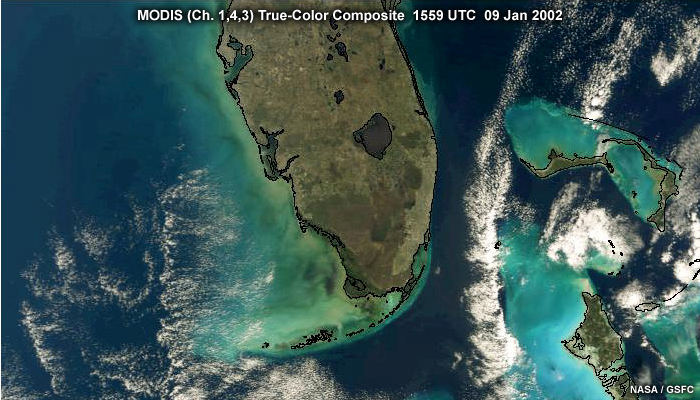
MODIS gives us sharper detail and the ability to quantify and understand bio-optical properties of the ocean surface, often called “ocean color.” Ocean color depends on the number of microscopic marine plants, called “phytoplankton.” These plants contain chlorophyll, a green pigment.
The waters of Florida are normally bluish green as shown in this image from January 2002.
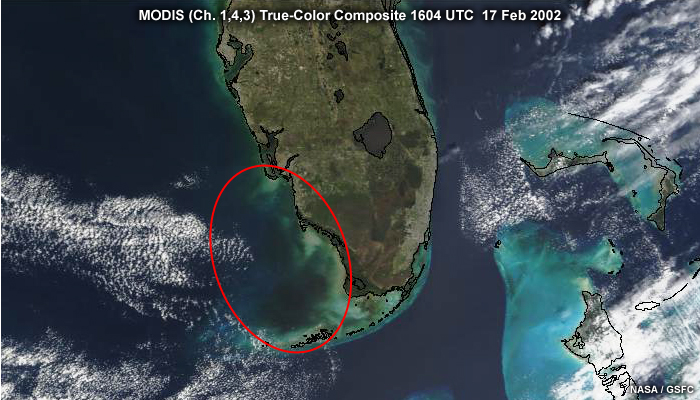
But in February 2002 a mysterious patch of nearly black water appeared off of Florida’s west coast. The feature is shown prominently in this image, taken in mid-February.
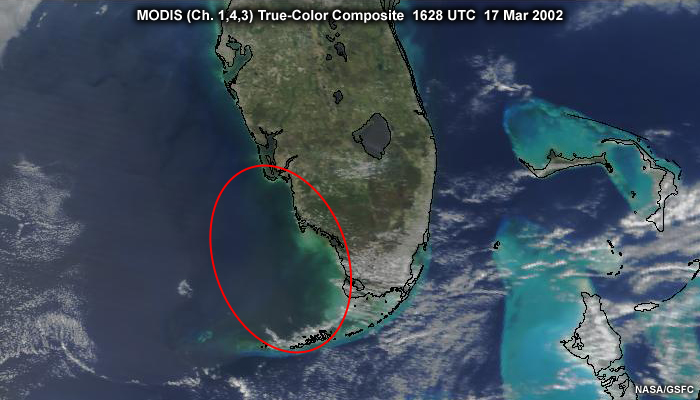
It diminished a few weeks later as seen in this image from March 2002. The dark coloration was caused by a high concentration of microscopic plants and other dissolved matter, sometimes known as a red tide or algal bloom. Water associated with algal blooms commonly varies in color from purple to almost pink, but more dense algal blooms absorb more sunlight and can appear almost black as seen in the February MODIS image. Similar to MODIS, additional visible channels give VIIRS the ability to produce ocean color products that help monitor the marine ecosystem.
True- and False-Color Imagery with VIIRS » SeaWiFS Dust Enhancement

While still operating, one of the popular uses of the SeaWiFS imager was for dust and aerosol detection over the ocean. Here is a SeaWiFS dust enhancement product that resembles a false-color product we saw earlier for MODIS, but is designed to highlight suspended dust. Look at how the dust, shown in an orange-pink coloration, is moving northeastward ahead of an approaching frontal system. Products like these offer us a preview of the dust and aerosol detection capabilities with VIIRS.
True- and False-Color Imagery with VIIRS » Summary
- MODIS flies on the Terra and Aqua satellites
- MODIS and SeaWiFS have multiple channels in the visible spectrum that allow for true-color imagery
- MODIS simulates high resolution multispectral imagery that will be available from VIIRS
- VIIRS will provide high resolution true- and false-color imagery
- VIIRS suite of multispectral products will help improve forecaster productivity
- VIIRS high resolution color imagery will help in the characterization of surface features and clouds
- VIIRS high resolution color imagery will help in the detection of volcanic eruptions and associated ash plumes
Day/Night Channel
Day/Night Channel » Introduction
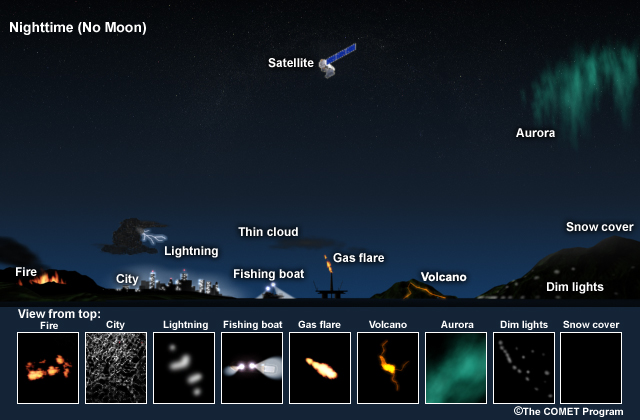
Besides great spatial resolution, the DMSP OLS also has the Day/Night channel, with the capability of imaging with or without moonlight. The images from this channel are increasingly sought after, but many users don't understand them well. What are all the features that can be seen? We'll explore those in more detail on the following pages.
Day/Night Channel » Introduction » More information on OLS and VIIRS Day/Night Channels
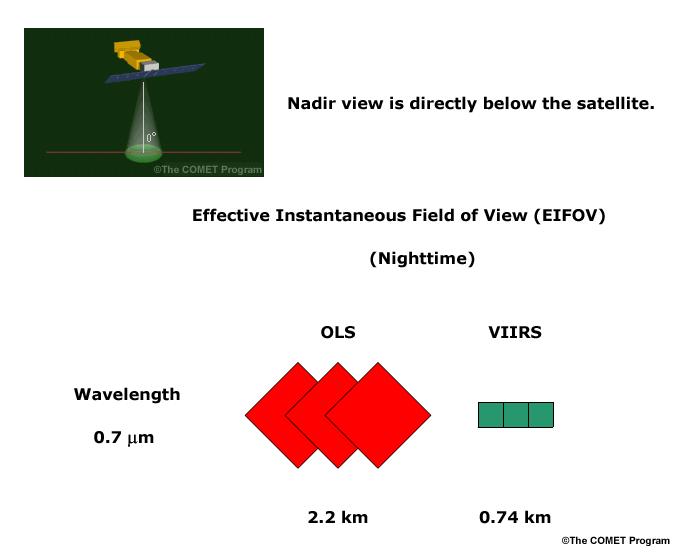
The main DMSP OLS contribution to VIIRS is the legacy of the nighttime visible channel. The VIIRS improvement can be best understood by using a measure known as the effective instantaneous field of view (or EIFOV).
This is the earth area viewed by the satellite in a single instance in time and represents the ability of the satellite to resolve features without blurring. The larger this value, the more overlap there is between adjacent EIFOVs and the worse the image quality. Notice the threefold decrease in EIFOV with VIIRS, compared to OLS nighttime sensor. This improvement marks a crucial enhancement in the ability to observe lights associated with smaller cities and fires.
Day/Night Channel » No Moon

Whether natural or generated by humans, lights on the earth and in the atmosphere are brightest in the Day/Night channel when there is little or no moon. The detector's sensitivity to light is increased to detect faint city lights, lightning, lights from fishing boats, gas flares from offshore oil platforms, and molten lava from volcanoes. The aurora can often be observed over the polar regions, which is of great interest to the space weather community. Lights from middle-sized and major cities easily penetrate most clouds, and only the thickest cloud cover, like a thunderstorm, can prevent lights from being detected by the satellite. However, without reflected lunar light, the clouds themselves cannot be seen by the day/night channel.
Day/Night Channel » Half Moon - First Quarter Phase
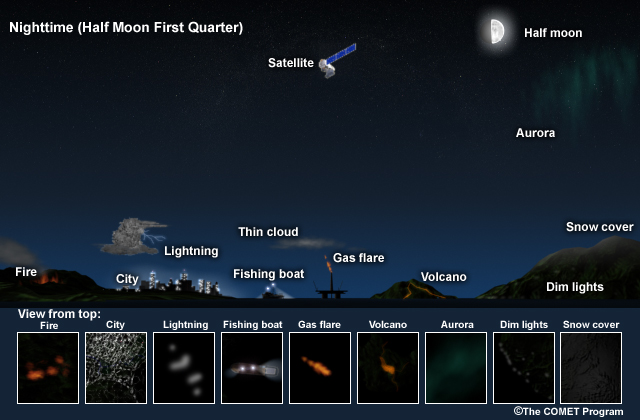
With half of the lunar face showing, the moon is in its first quarter phase. With increasing lunar phase and illumination, the day/night channel's gain is decreased, and clouds come dimly into view. Many of the dimmer light sources may become undetectable on successive nights during this period.
A rule of thumb is that clouds can be seen in quarter-moon phase and above, but this is not a completely reliable indicator.
Day/Night Channel » Full Moon
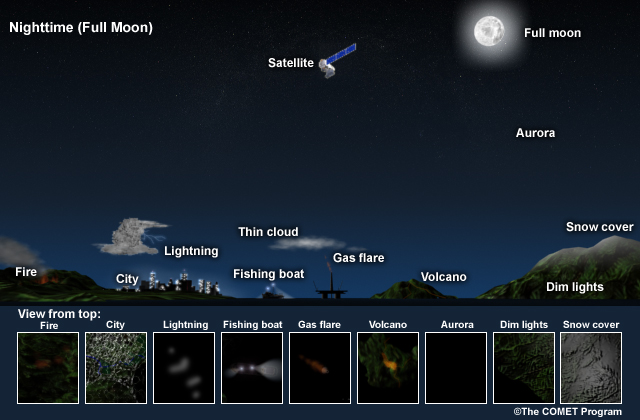
During a full moon the day/night channel's gain is set to a minimum, making city lights appear at their faintest. But clouds can be seen vividly in the reflected moonlight. Snow on the ground can be seen, and land/sea boundaries become distinct. Under a full moon, nighttime visible images resemble daytime visible images.
Day/Night Channel » No Moon Image
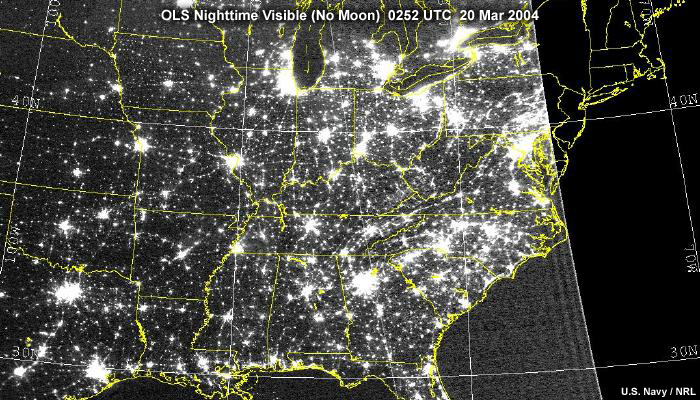
Let’s look at some real examples taken during the lunar cycle. With no moon we just see city lights and no clouds. This is because without lunar reflection, only self-illuminating light sources show up. The instrument gain is set on high in the absence of moonlight so that even small towns and shopping centers along highways become visible.
Day/Night Channel » Moon - Nearly Half Full

A few days later clouds start to appear in the imagery. However, even with a half moon, the clouds are somewhat indistinct. More moonlight is needed for better imaging. One advantage of this channel is that even thicker clouds do not completely obscure bright city lights on the ground. For example, look at the cities that appear through the clouds in Iowa. In other areas, however, the lights are not city lights at all, but lightning. Notice the lightning embedded within the squall line in northern Oklahoma.
Day/Night Channel » Moon - Nearly Half Full » Lightning with the Nighttime Visible Channel
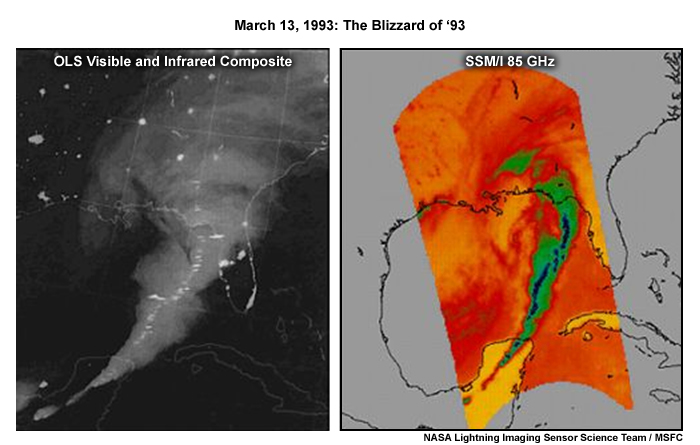
Let’s examine this nighttime visible image of the Blizzard of 1993 in the early stages of the storm’s development. Notice that you can see cities through some of the thinner cirrus. The mostly horizontal streaks along the squall line over the Gulf of Mexico are actually lightning flashes that can be seen in the very low light conditions at night. Can you tell the difference between the flashes and the city lights?
On the right is a Special Sensor Microwave Imager (SSM/I) image from the same DMSP satellite. This 85-GHz image shows the precipitation for the same squall line shown by the visible-infrared composite image on the left. The cold microwave temperatures represented by embedded greens and blues indicate ice-phase precipitation aloft, and heavy rain at the surface.
Day/Night Channel » Moon - Nearly Full
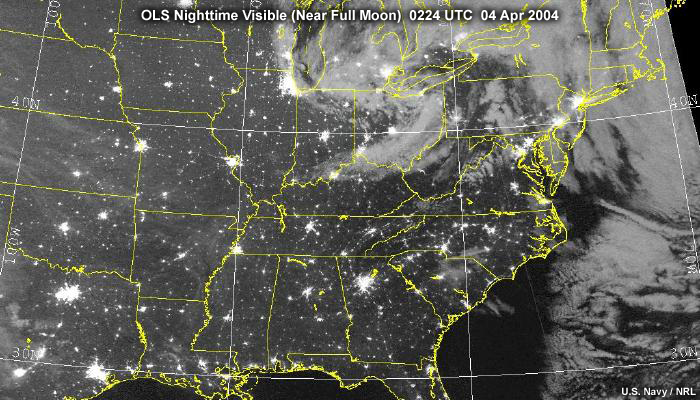
Now at full moon, clouds are more fully illuminated. Since the instrument gain is decreased during a full moon to avoid saturation by brightly reflective clouds, cities will grow relatively dimmer. But they do not go away altogether. Notice that the highway grid is more difficult to see in this image than in the “no moon” image shown earlier.
Day/Night Channel » Moon - Nearly Full » Solar Glare Contamination
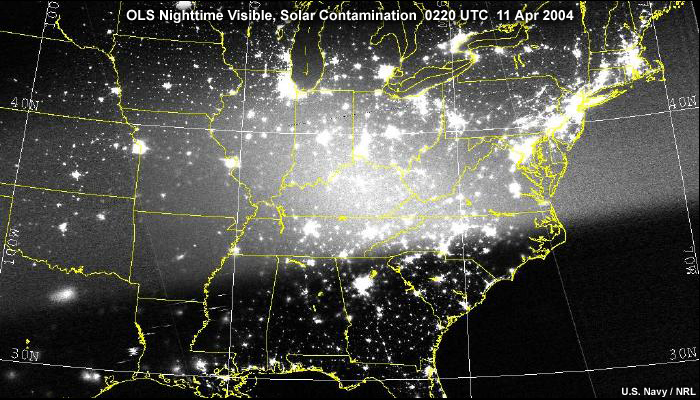
The moon is about three-quarters full in this image, more than sufficient for cloud imaging. But why are there are no clouds visible? The answer is that the moon is below the horizon and not illuminating the scene. There is, however, considerable solar glare over a portion of the scene. Solar glare appears during particular sun-satellite geometry configurations when the sun shines directly into the instrument. The VIIRS imager eliminates this problem.
Day/Night Channel » Aurora

With little or no moon, the OLS can detect one of the most visually amazing space weather phenomena, the aurora. Here is an example of the aurora borealis over the eastern United States. The aurora is a vibrant array of light in the night sky, caused by the collision of charged particles from the sun with atoms in Earth's thermosphere. The aurora borealis (northern lights) appear in the Northern Hemisphere.
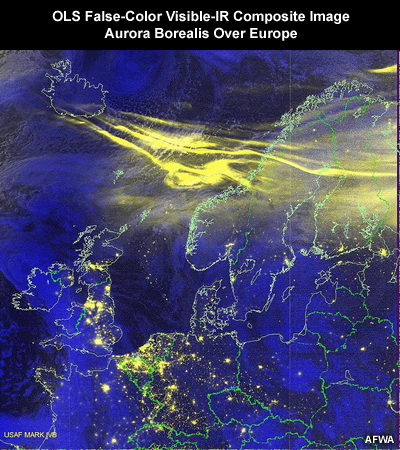
This image is a false-color composite of the aurora borealis using OLS infrared and nighttime visible data over Europe.
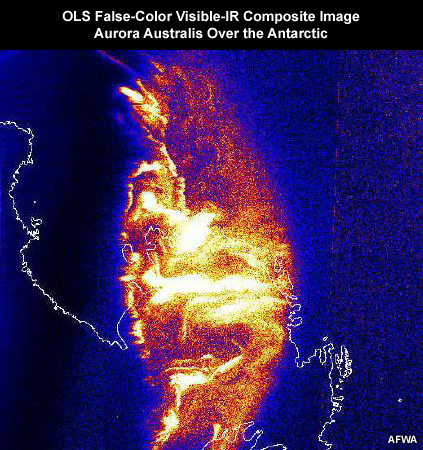
The aurora australis (southern lights), with innumerable spatial forms, is the Southern Hemisphere counterpart.
Day/Night Channel » East Coast Lights
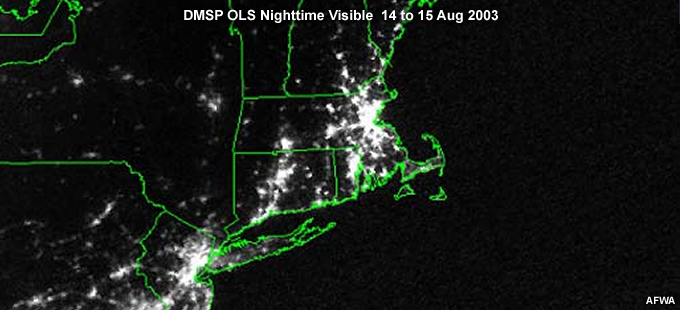
A typical DMSP OLS nighttime view of northeastern U.S. lights seems normal at first glance. You can readily see cities such as New York City and Boston.
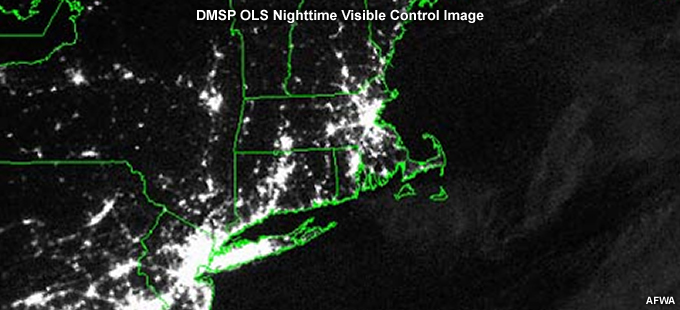
But wait; let's compare this image to one on a previous night with more and brighter lights. The first relatively ”dim“ image is of the great power blackout on 14 to 15 August, 2003. This example is a preview of how the VIIRS Day/Night visible channel will be a significant tool to emergency personnel attempting a quick assessment during power outages.
Day/Night Channel » East Coast Lights »OLS Image Artifacts

The DMSP OLS imager produces a variety of image artifacts that sometimes affect image quality. The nearly linear north-south lines in this image, for example, are due to the way the observations are scanned and processed. This effect disappears with VIIRS.
Day/Night Channel » Clouds Obscure View Over Texas: No Moon Case
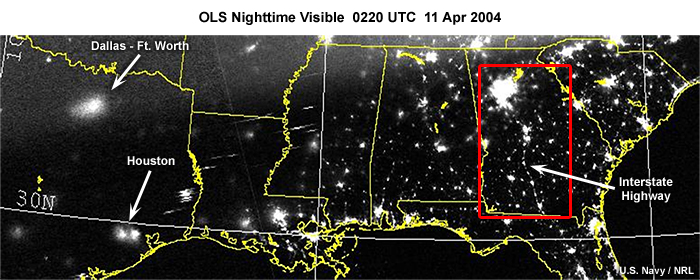
Should you assume there are blackout conditions present if you do not see familiar cities at night?
Look at the DMSP OLS nighttime visible image. City lights are prominent over the southeast. Over Georgia, for example, you can see the towns that are aligned with Interstate Highway 75. Cities also dot Alabama and parts of Mississippi. But over much of Louisiana and especially Texas very few cities appear, with the exception of Houston in the south and Dallas Fort Worth in the north. The problem is not a blackout, but heavy cloud cover that obscures the cities in Texas. Since there is no moonlight, those clouds do not appear in the visible image.
There are two ways of determining that it’s overcast and not a blackout. First, you can see the diffuse appearance of the lights from Houston or Dallas Fort Worth. This is the result of only partial attenuation of the light by heavy overcast.
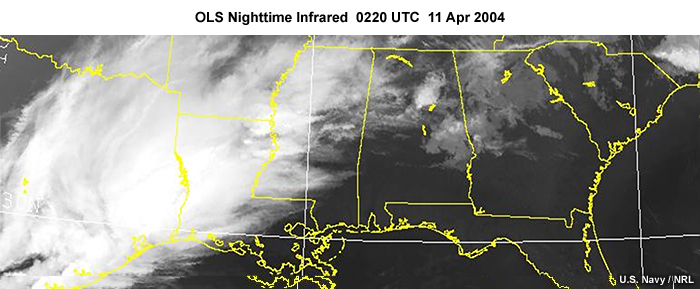
And second, you can look at the corresponding infrared image to see where obvious cloud cover is present.
Day/Night Channel » More on Nighttime Cloud Imaging» Cloud Identification Over the Antarctic
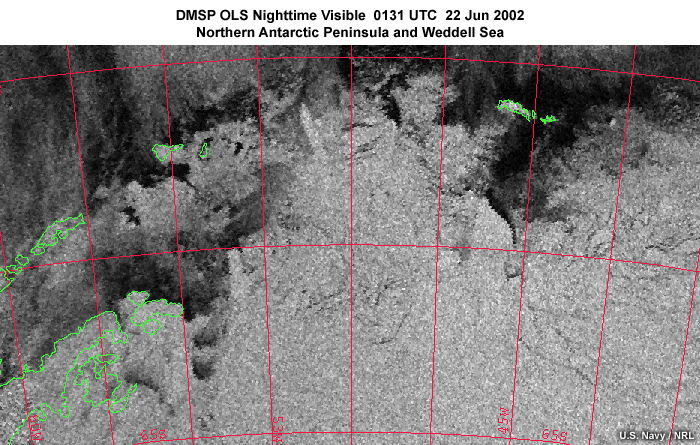

In the Antarctic night, the infrared is often transmitted in fine mode, with the visible in smooth mode. Given the absence of daylight, IR images give the most useful information about clouds and ice. Look at this fine resolution IR image over the northern most part of the Antarctic Peninsula and adjacent Weddell Sea.
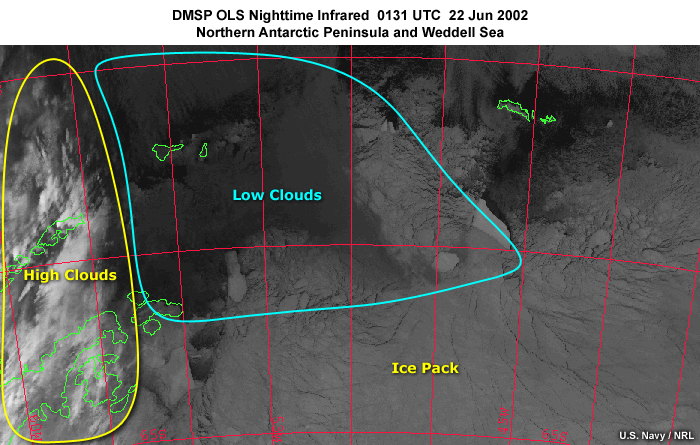
In the infrared image you can see elaborate detail over the wintertime ice pack. But clouds obscure much of the scene, especially in the west.
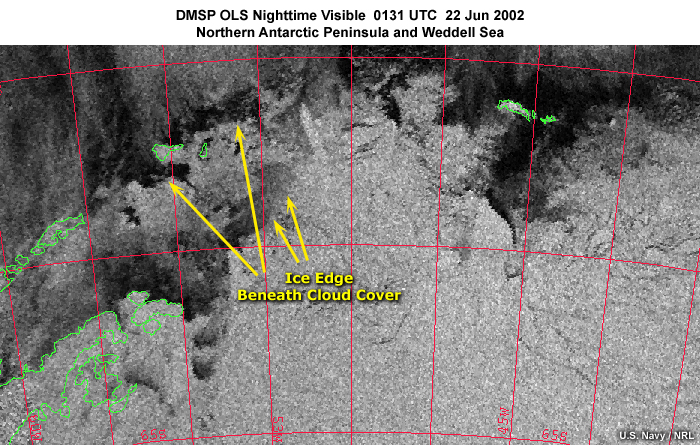
Because reflected moonlight penetrates the thin Antarctic clouds in the visible image, we can see the edges of the polar ice pack in various places that are obscured in the infrared image.
Day/Night Channel » Bispectral Composite for Highlighting Clouds

A composite image that combines infrared and visible components can eliminate the need to view each image separately. Brightness temperatures form the previous infrared image over the southern U.S. were assigned to shades of blue and green, and visible count values were assigned to shades of red. From the resulting color composite it is easy to see that Texas is cloud covered, explaining the diffuse appearance of city lights. On the other hand Georgia has few clouds overhead, which allows cities to stand out and be more clearly defined.
Day/Night Channel » Tropical Cyclone Imaging at Night
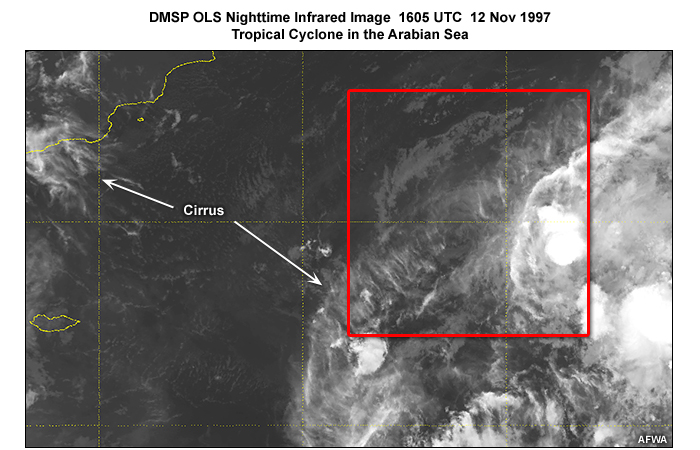
Another useful application for the nighttime visible is the imaging of tropical cyclone circulations at low levels. In other words, those circulations not associated with mid- or high-level cloud features. Let’s look first at the DMSP OLS infrared image. The infrared image readily highlights the cold cirrus. But can you see the signature of a low-level circulation inside the red box?
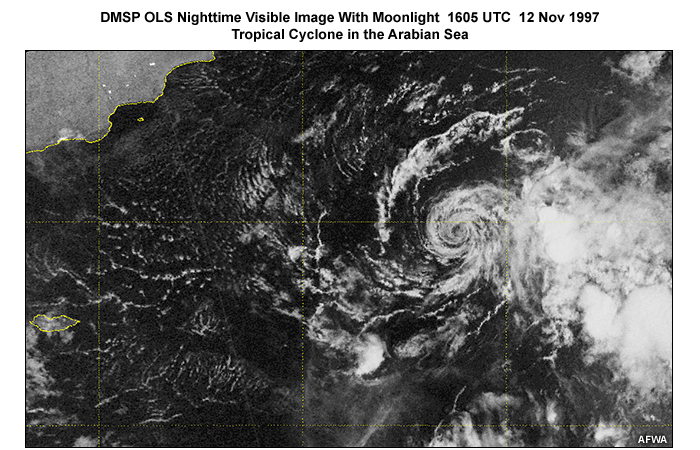
Now let’s look at a nighttime visible image under moonlight. The low-level cloud circulation associated with the storm shows up easily. Such a capability can be crucial for detecting and estimating intensities of relatively weak tropical storms during nighttime hours.
Day/Night Channel » Quick Quiz
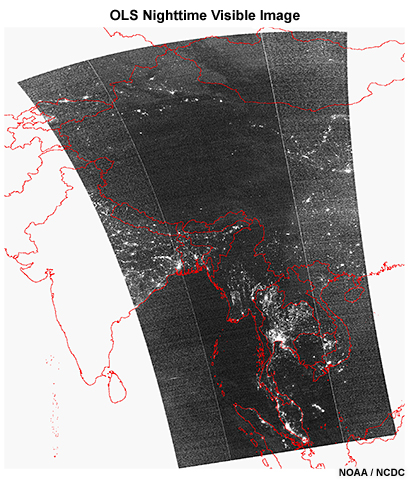
Assume that the moon is above the horizon.
Can you tell the
phase of the moon when this image was taken?
The correct answer is a).
Feedback: Yes we can. The phase is new moon, or near to it. There is little illumination to show cloud cover.
Day/Night Channel » Summary
- The day/night channel reveals different features depending on the moon’s phase
- Both man-made and natural sources of light are best viewed during no-moon conditions
- Clouds become visible and many dimmer light sources undetectable with a half moon or greater
- Nighttime visible imagery resembles daytime visible during the full-moon phase
- In no-moon imagery, even smaller cities, towns, and busy highways are apparent
- In half-moon imagery, both clouds and light sources are apparent
- In near full-moon imagery, clouds are more fully illuminated and light sources appear dimmer
- VIIRS eliminates the solar glare contamination present in OLS imagery
- The aurora can be observed under no-moon conditions at higher latitudes
- Thick clouds can obscure all but lights from the largest cities
- Nighttime visible imagery reveals ice edges through thin clouds
- OLS bispectral visible and infrared composite imagery distinguishes cities and cloud cover
- OLS nighttime visible imagery can observe low-level cloud cover through thin cirrus
- Image composites of city lights over time reveal a broad range of light sources and their relative intensities
Module Summary
Section 1: Introduction
- VIIRS is the primary visible and infrared environmental imaging instrument for the Suomi NPP satellite and future U.S. JPSS polar-orbiting satellites
- VIIRS draws on technologies from several imagers including DMSP OLS, NOAA AVHRR, Terra and Aqua MODIS, and SeaStar SeaWiFS
- VIIRS has 22 channels designed to support a large suite of multispectral products (EDRs) at high spatial resolution
- The Suomi NPP polar-orbiting satellite provides global coverage twice per day
- VIIRS imagery will be available to users in near real time
Section 2: VIIRS Resolution Improvements
- VIIRS includes imaging channels at 0.76 km (17 channels) and 0.38 km (5 channels) resolution
- All six visible, shortwave, and longwave infrared spectral channels on AVHRR are on VIIRS at higher resolution
Section 3: DMSP Contributions
- Improved data transmission capabilities with Suomi NPP satellite will eliminate the tradeoff between image resolution and transmission bandwidth required for the DMSP OLS imager
- Increased bit depth (4096 gray shades per pixel) will significantly enhance VIIRS' ability to distinguish features
- VIIRS multispectral imaging capabilities greatly extends the range of products and applications available over the two OLS spectral channels
Section 4: Edge-of-Scan Effects
- VIIRS footprint geometry improves on OLS
- VIIRS day/night channel maintains the same spatial resolution across the swath
- VIIRS preserves resolution across the entire scan, minimizing the negative impact that edge-of-scan blurring has on derived products
Section 5: True- and False-Color Imagery with VIIRS
- VIIRS provides spectral channels for high-resolution true-color imagery
- High-resolution true-color imagery helps in the characterization of surface features, clouds, atmospheric dust, and aerosols
- Improved data communications and data processing will give forecasters more timely access to VIIRS products
Section 6: Day/Night Channel
- The day/night channel reveals different features depending on the moon's phase
- Nighttime visible imagery can reveal surface features through thin clouds
- Nighttime visible imagery can reveal low level cloud features through high level thin cloud cover
- Bispectral visible/infrared composite imagery highlights cities and clouds
- VIIRS eliminates the solar glare contamination present in OLS imagery
You have reached the end of the lesson. Please complete the quiz and share your feedback with us via the user survey.
Resources
Resources & References
The following Internet-based resources and references provide additional information on the topics presented in this module:
Internet Resources
- To see the JPSS spacecraft and instruments, including images and data from the VIIRS
imager.
https://www.jpss.noaa.gov/index.html - To read about VIIRS facts and science, and see sample images.
https://www.jpss.noaa.gov/mission_and_instruments.html - For the lastest Suomi NPP mission news, media resources and multimedia.
http://www.nasa.gov/mission_pages/NPP/main/index.html - Early VIIRS images can be seen here,
http://www.nasa.gov/mission_pages/NPP/news/viirs-firstlight.html
and here,
http://cimss.ssec.wisc.edu/goes/blog/archives/9229 - NOAA's information portal for the NPP and JPSS missions, including imagery from VIIRS.
http://www.nesdis.noaa.gov/jpss/ - NOAA NESDIS JPSS and VIIRS related news stories.
https://www.jpss.noaa.gov/news.html - For sample imagery, science documents, and other reference information related to Suomi NPP,
visit the VIIRS Imagery and Visualization Team Web site.
http://rammb.cira.colostate.edu/projects/npp/ - Naval Research Laboratory (NRL)'s VIIRS real–time imagery for selected areas of
interest.
https://www.nrlmry.navy.mil/NEXSAT.html - For a chart summarizing VIIRS spectral bands and corresponding spatial resolutions, and
information about VIIRS related activities at NOAA NESDIS Center for Satellite Applications
and Research (STAR).
http://www.star.nesdis.noaa.gov/smcd/emb/vci/VH/npp_bandsForVH.php
References
- Johnson, D.B., P. Flamant, and R.L.Bernstein, 1994: High-resolution satellite imagery for mesoscale meteorological studies. Bull. Amer. Meteor. Soc., 75, 5-33.
- Lee, T.E., et al., 2006: NASA MODIS previews VIIRS capabilities. Wea. Forecasting, 21, 649-655.
- Lee, T.E., et al., 2006: The NPOESS day/night visible sensor. Bull. Amer. Meteor. Soc., 87, 191-199.
- Miller, S.D., et al., 2006: NexSat: Previewing NPOESS/VIIRS imagery capabilities. Bull. Amer. Meteor. Soc., 87, 433-446.
- Schueler, C.F., et al., 2003: NPOESS VIIRS: next-generation polar-orbiting atmospheric imager. Optical Remote Sensing of the Atmosphere and Clouds III. Proc. SPIE, 4891, 50-64.
- Schueler, C.F., et al., 2002: NPOESS VIIRS sensor design overview. Earth Observing Systems VI. Proc. SPIE, 4483, 11-23.
Contributors
COMET Sponsors
The COMET® Program is sponsored by NOAA National Weather Service (NWS), with additional funding by:
- Bureau of Meteorology of Australia
- Bureau of Reclamation (United States Department of Interior)
- European Organisation for the Exploitation of Meteorological Satellites (EUMETSAT)
- Meteorological Service of Canada (MSC)
- NOAA National Environmental Satellite, Data and Information Service (NESDIS)
- Naval Meteorology and Oceanography Command (NMOC)
Project Contributors
Senior Project Manager
- Wendy Abshire — UCAR/COMET
Project Lead
- Patrick Dills — UCAR/COMET
Instructional Design
- Bruce Müller — UCAR/COMET
- Dr. Sherwood Wang — UCAR/COMET
Principal Science Advisors
- Thomas Lee — Naval Research Laboratory (Monterey) (NRL)
Associate Science Advisors
- Patrick Dills — UCAR/COMET
Graphics/Interface Design
- Steve Deyo — UCAR/COMET
- Marianne Weingroff — UCAR/COMET
Multimedia Authoring/AUDIO PRODUCTION
- Bruce Müller — UCAR/COMET
COMET HTML Integration Team 2019
- Tim Alberta — Project Manager
- Dolores Kiessling — Project Lead
- Steve Deyo — Graphic Artist
- Jordan Goodridge — Student Assistant/Web Developer
- Gary Pacheco — Lead Web Developer
- David Russi — Translations
- Alex Sheehan — Web Developer
- Tyler Winstead — Web Developer
COMET Staff, Spring 2012
Director
- Dr. Timothy Spangler
Administration
- Elizabeth Lessard, Administration and Business Manager
- Lorrie Alberta
- Michelle Harrison
- Hildy Kane
Hardware/Software Support and Programming
- Tim Alberta, Group Manager
- Bob Bubon
- Ken Kim
- Mark Mulholland
- Victor Taberski - Student Assistant
- Chris Webber - Student Assistant
- Malte Winkler
Instructional Designers
- Dr. Patrick Parrish, Senior Project Manager
- Dr. Alan Bol
- Maria Frostic
- Lon Goldstein
- Bryan Guarente
- Dr. Vickie Johnson
- Tsvetomir Ross-Lazarov
- Marianne Weingroff
Media Production Group
- Bruce Müller, Group Manager
- Steve Deyo
- Dan Riter
- Carl Whitehurst
Meteorologists/Scientists
- Dr. Greg Byrd, Senior Project Manager
- Wendy Schreiber-Abshire, Senior Project Manager
- Dr. William Bua
- Patrick Dills
- Matthew Kelsch
- Dolores Kiessling
- Dr. Arlene Laing
- Dave Linder
- Dr. Elizabeth Mulvihill Page
- Amy Stevermer
Spanish Translations
- David Russi
NOAA/National Weather Service - Forecast Decision Training Branch
- Anthony Môstek, Branch Chief
- Dr. Richard Koehler, Hydrology Training Lead
- Brian Motta, IFPS Training
- Dr. Robert Rozumalski, SOO Science and Training Resource (SOO/STRC) Coordinator
- Ross Van Til, Meteorologist
- Shannon White, AWIPS Training
Meteorological Service of Canada Visiting Meteorologists
- Brad Snyder
